Learn how to make tender and juicy Chicken Teriyaki at home in less than 20 minutes using the traditional Japanese cooking method. You‘ll love the succulent and pan-seared boneless chicken thighs glazed in an easy, four-ingredient homemade sauce.
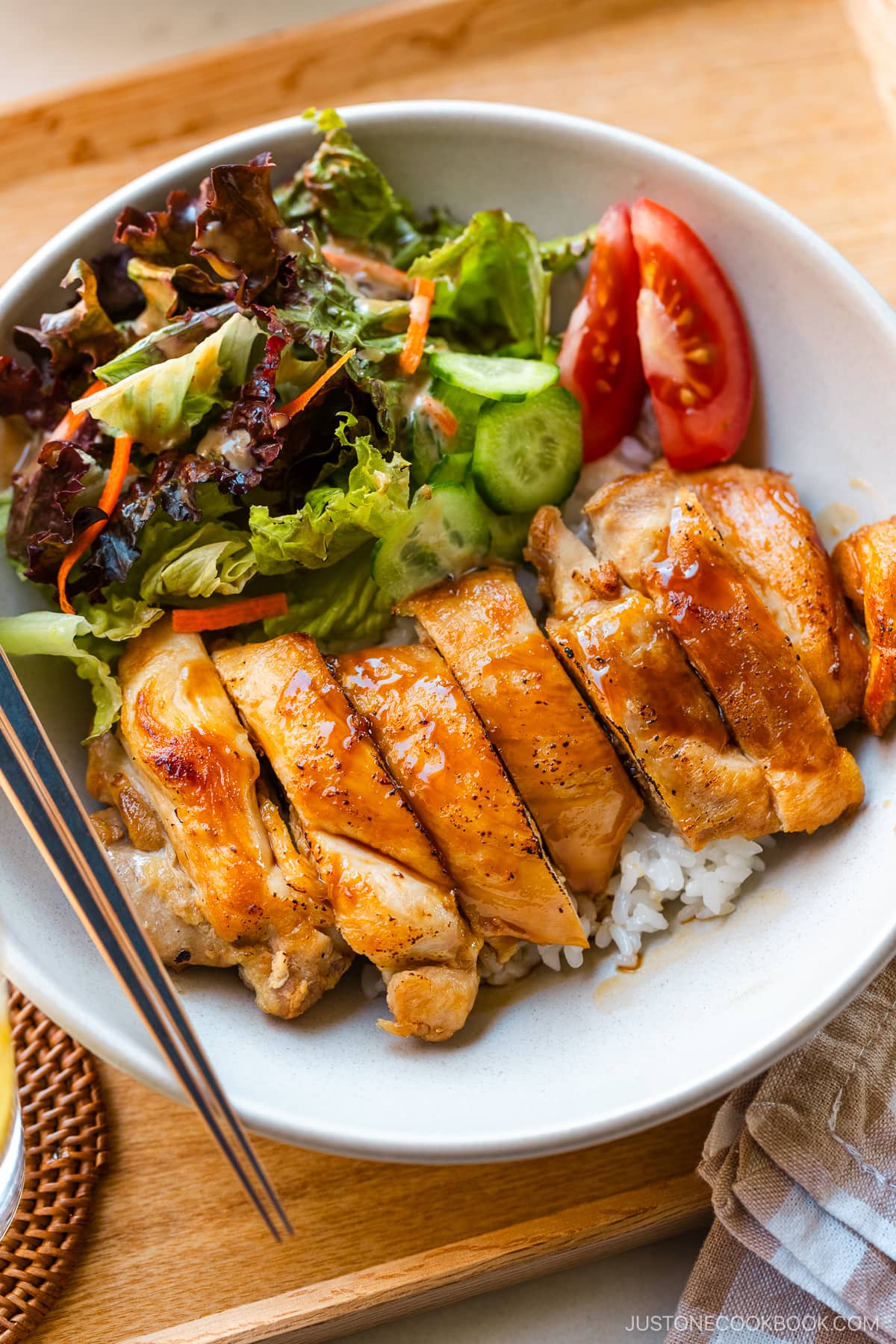
Everybody loves some good, juicy chicken in a sweet and glossy glaze. This is why chicken teriyaki, a humble Japanese dish, is so popular everywhere in the world! In this recipe, I’ll show you how to make authentic Chicken Teriyaki at home the way it’s done in Japan. This foolproof Japanese method gives you the juiciest meat, crispest skin, and most traditional flavor. It’s so good, easy, and a winner for your weeknight dinner.
If you’re craving more teriyaki recipes, try my Teriyaki Salmon, Teriyaki Tofu, and Teriyaki Chicken Meatballs next!
What is Chicken Teriyaki?
Teriyaki (照り焼き) in Japanese actually describes a cooking method that was established in Japan in the 1600s. Teri (照り) means luster from the shiny glaze, and yaki (焼き) means broil, grill, or pan-fry. Chicken and fish are the most popular foods to prepare teriyaki-style in Japan. Japanese home cooks most commonly pan-fry the chicken and finish it with a simple homemade tare (タレ) and not bottled sauce. Outside of Japan, the word teriyaki is now synonymous with both the teriyaki-style dish and the glossy sauce itself.
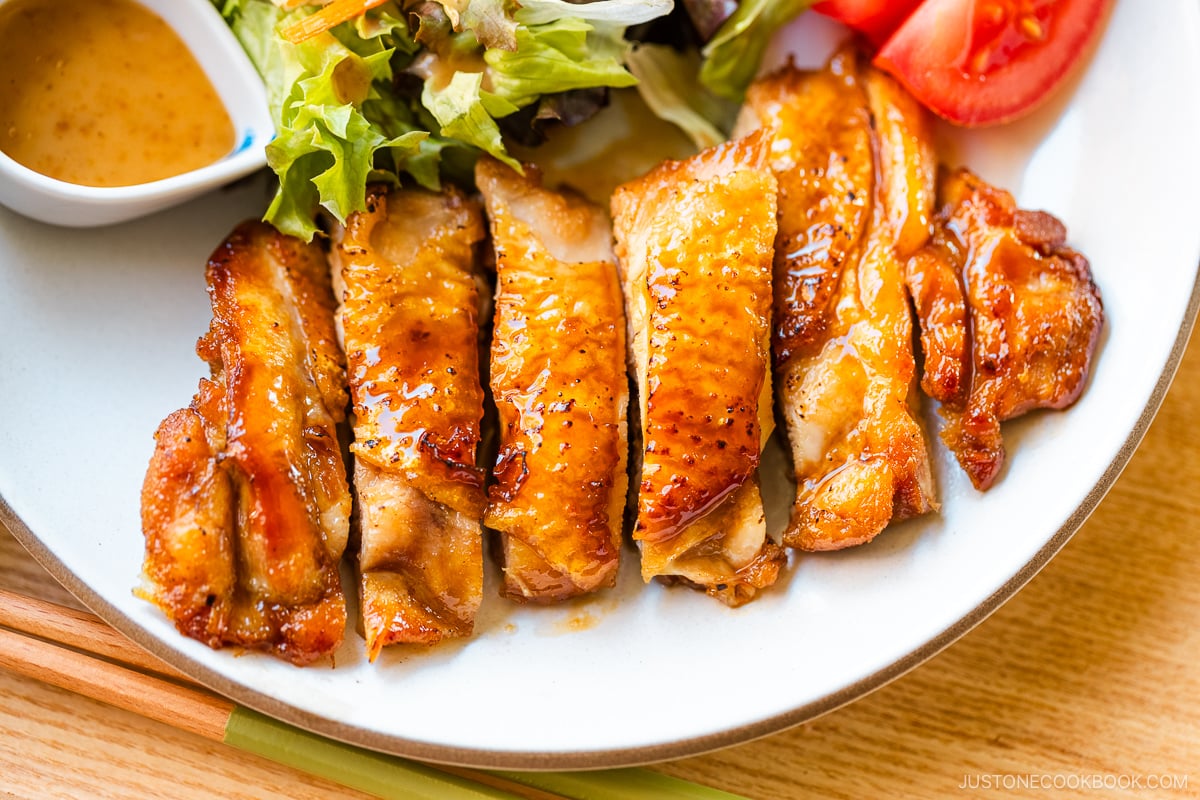
Table of Contents
Why I Love This Recipe
- Juicy, succulent chicken – The skin on the chicken thighs acts as a protective layer to keep the meat juicy and tender. I’ll teach you how to sear the skin to make it crispy and bring out its delicious flavor.
- Simple, four-ingredient sauce – The homemade sauce uses common Japanese pantry staples that cook right in the pan with the chicken, so you don’t have to make it beforehand. I’ll show you how to caramelize it to make a shiny glaze that’s so irresistible.
- Quick and easy to make – You can enjoy this delicious teriyaki chicken in less than 20 minutes! On busy weeknights, I rely on tasty and nutritious recipes like this that are ready in a flash.
- No need to marinate the meat – In Japan, we pan-fry the chicken teriyaki, so there’s no need to marinate the meat beforehand. In fact, the chicken skin will sear better if it’s dry when it hits the pan.
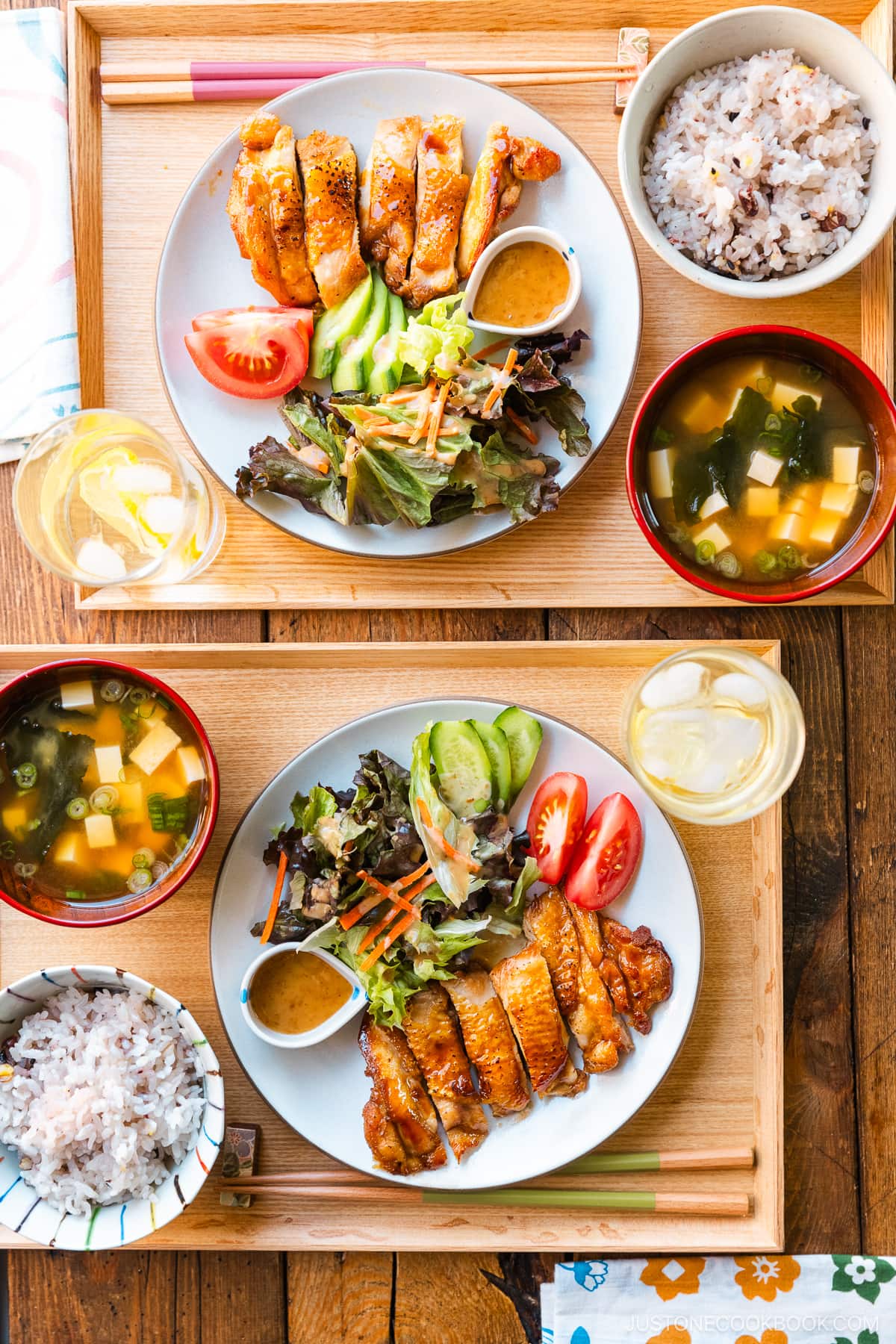
Ingredients for Chicken Teriyaki
It’s amazing that you only need a few pantry staples to make this classic and easy teriyaki chicken!
- Chicken thighs – boneless; preferably skin-on
- Salt and pepper
- Homemade teriyaki sauce
Find the printable recipe with measurements below.
Jump to RecipeSubstitutions
- Chicken thighs: For this recipe, I focus on skinless and boneless thighs since that‘s how they‘re commonly sold in the US. However, if you have the chance, I encourage you to try my skin-on recipe (the way we cook it in Japan) at the end of the instructions below. The flavorful skin provides a protective layer, keeps the meat juicy, and helps the delicious glaze adhere to the chicken. The skin itself yields a delicious flavor and acts like a magnet for the sticky sauce. Thighs are more forgiving to cook than chicken breasts, too. As a result, you get moist, flavorful, and juicy meat every time.
- Soy sauce: This is the most critical and prominent seasoning ingredient that gives teriyaki sauce a rich, dark color. It also imparts umami and saltiness. I highly recommend using only Japanese soy sauce, as it has a different flavor profile from Chinese, Thai, or Korean soy sauce. You could use low-sodium, tamari, or gluten-free versions.
- Sake: This Japanese rice wine is an essential ingredient in Japanese cooking. In addition to tenderizing the meat, the amino acids in sake remove any odor of the chicken. It adds subtle sweetness and umami as well. I recommend Gekkeikan, Sho Chiku Bai, or Ozeki. In a pinch, you can substitute Chinese rice wine, dry sherry, or water.
- Mirin: Mirin is Japanese sweet rice wine. This syrupy condiment adds a nice shine and natural sweetness to the sauce, helping to temper its saltiness. It also helps the flavor absorb and fully develop. If you don’t have it, you can substitute 1 Tbsp sake or water + 1 tsp sugar.
- Sugar: This sweetener balances out the saltiness of soy sauce, lending teriyaki sauce its signature sweet and savory flavor. We also need the sugar to thicken the sauce so it will caramelize beautifully and create a glossy sheen that coats the chicken. We don’t use honey and maple syrup because they have a strong flavor. You can substitute them if you wish, but please take care during cooking as they burn easily.
Key Kitchen Equipment
- Large frying pan with lid
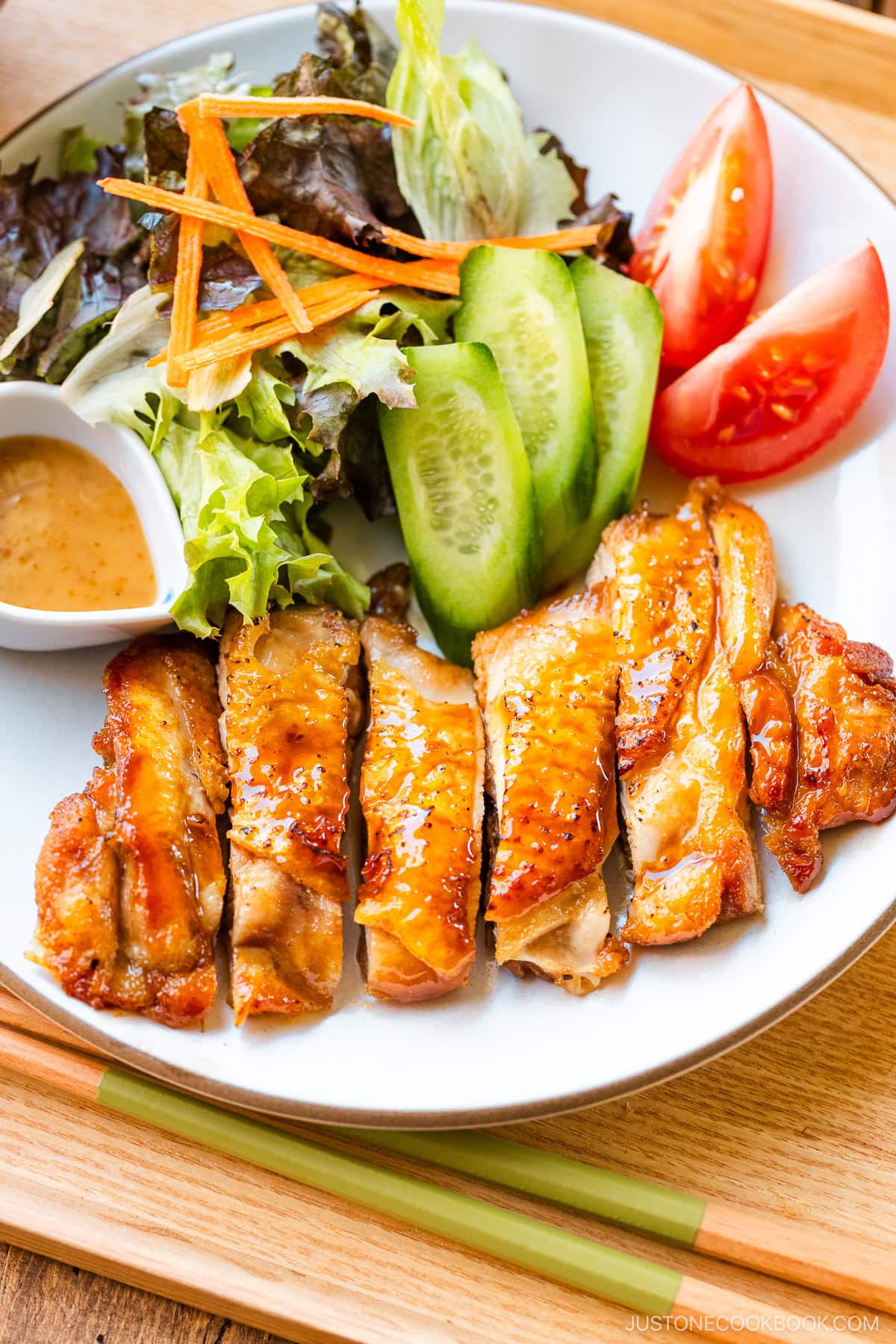
How to Make Chicken Teriyaki
Preparation
Step 1 – Mix the homemade teriyaki sauce. You can heat it in a microwave-safe bowl and stir to dissolve the sugar.
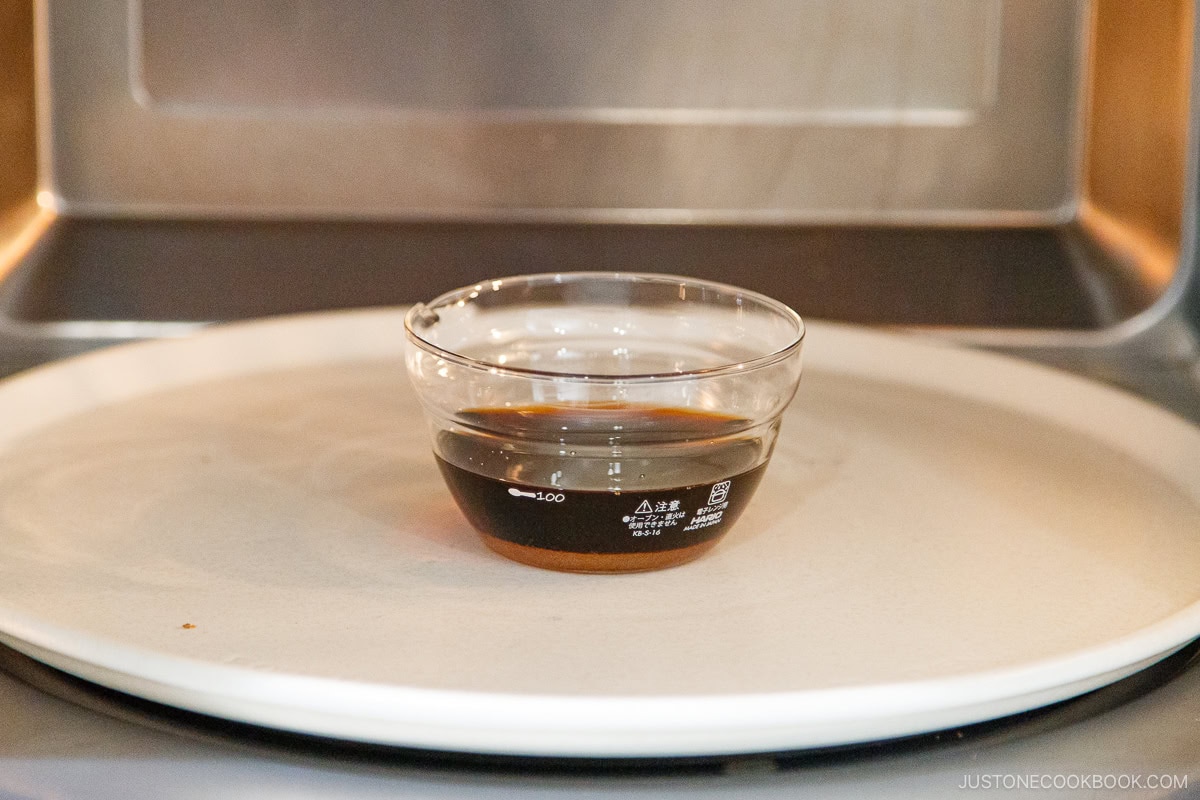
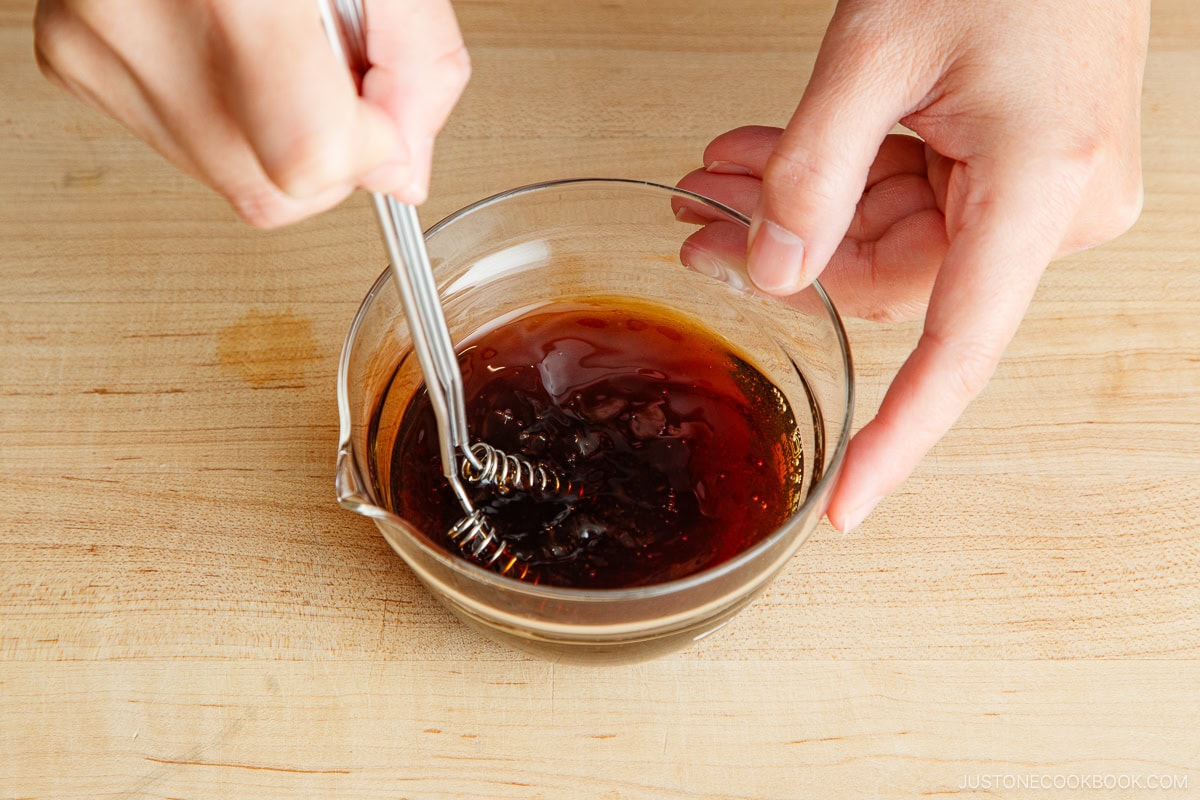
Step 2 – Prepare the chicken. Score and flatten the thigh meat to create an even thickness. This step is really important, so please don‘t skip it!
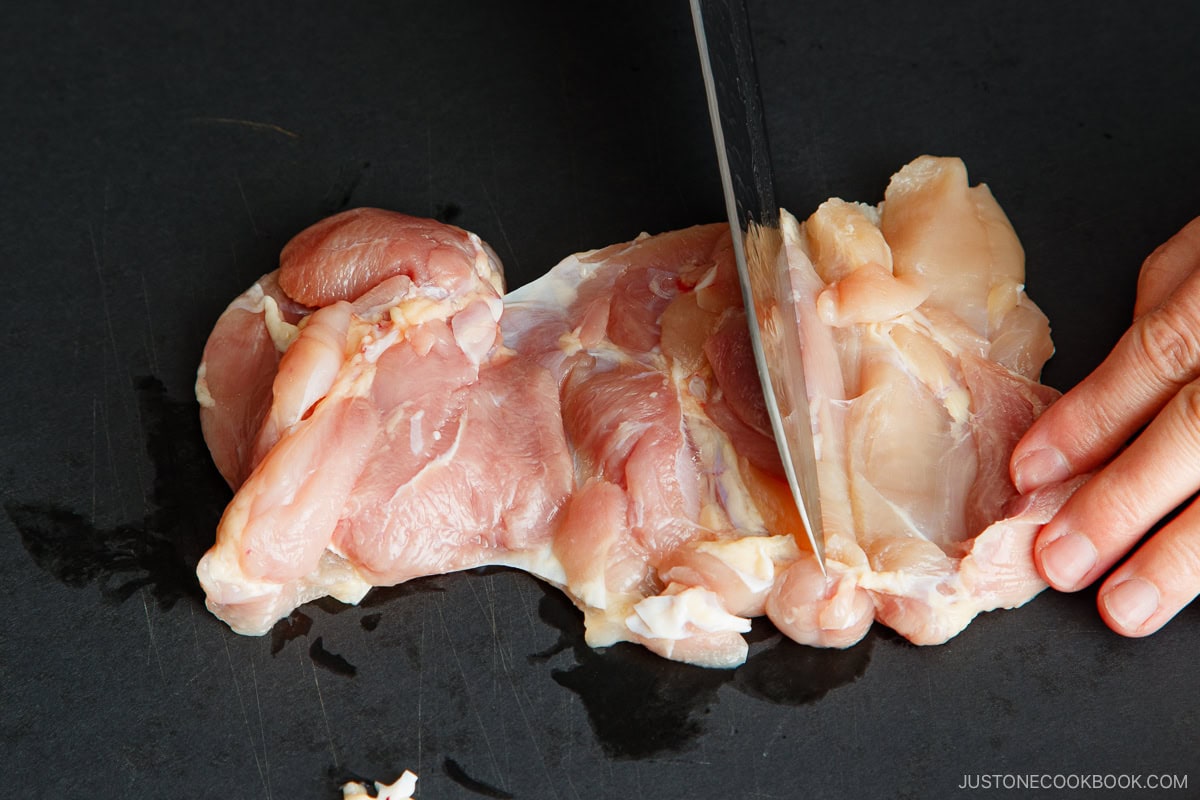

Cooking
Step 3 – Pan-fry the chicken. Preheat a large frying pan over medium to medium-high heat. Cook the chicken for 5 minutes, pressing down hard with a spatula for a nice sear. Flip over, sear the other side, and cover and steam it for another 3 minutes.
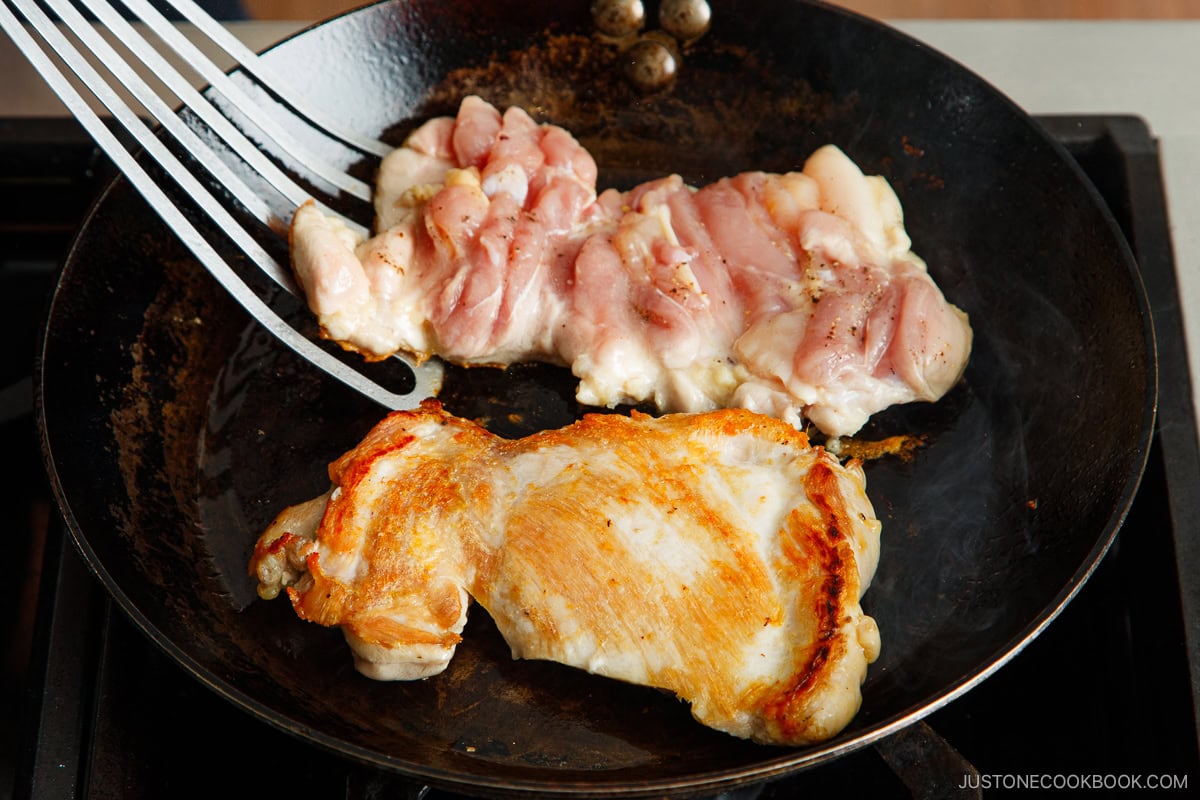
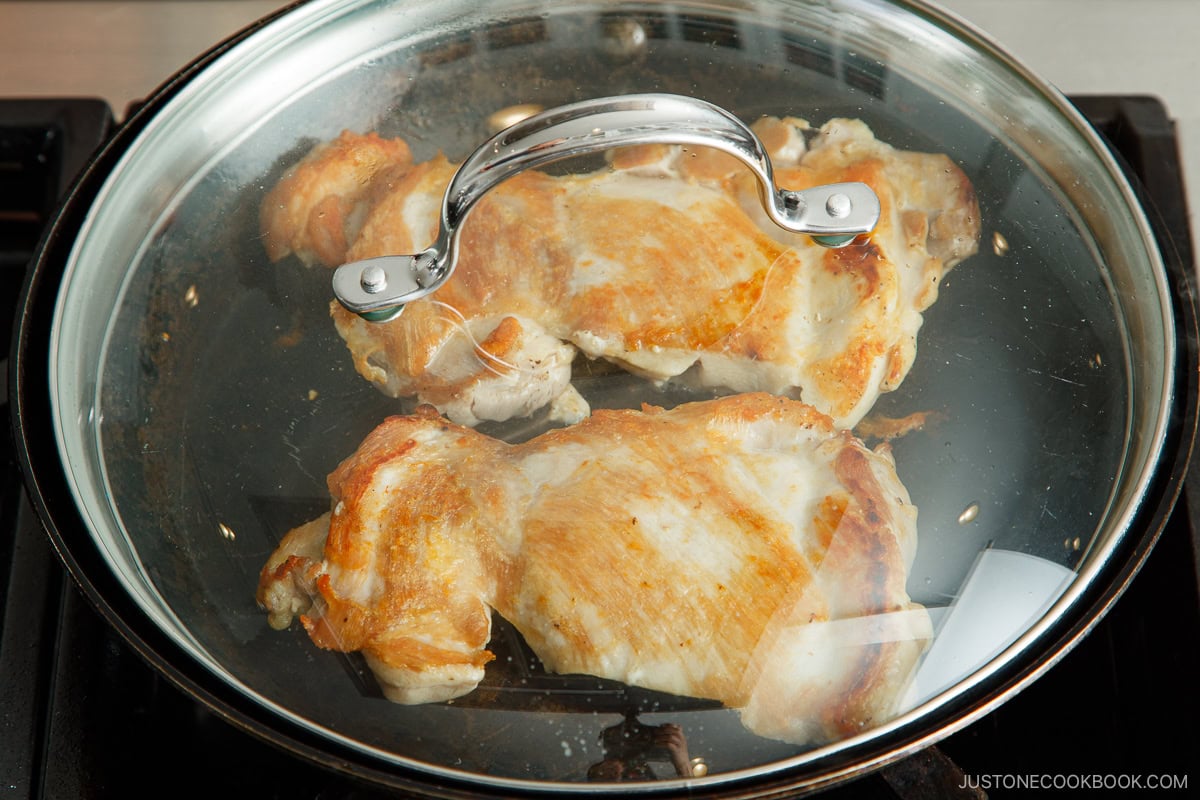
Step 4 – Add the teriyaki sauce to the pan. Spoon the sauce over the thighs until well coated. When the chicken is cooked through, remove from the pan.
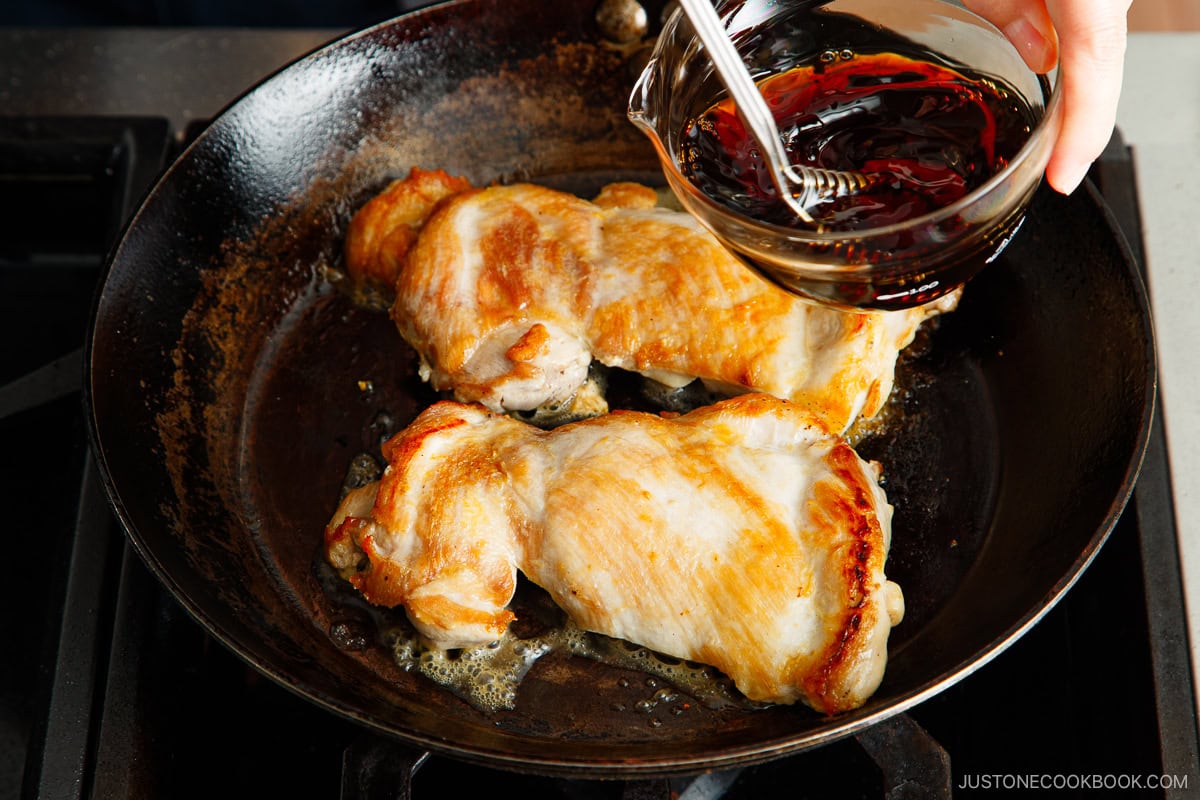
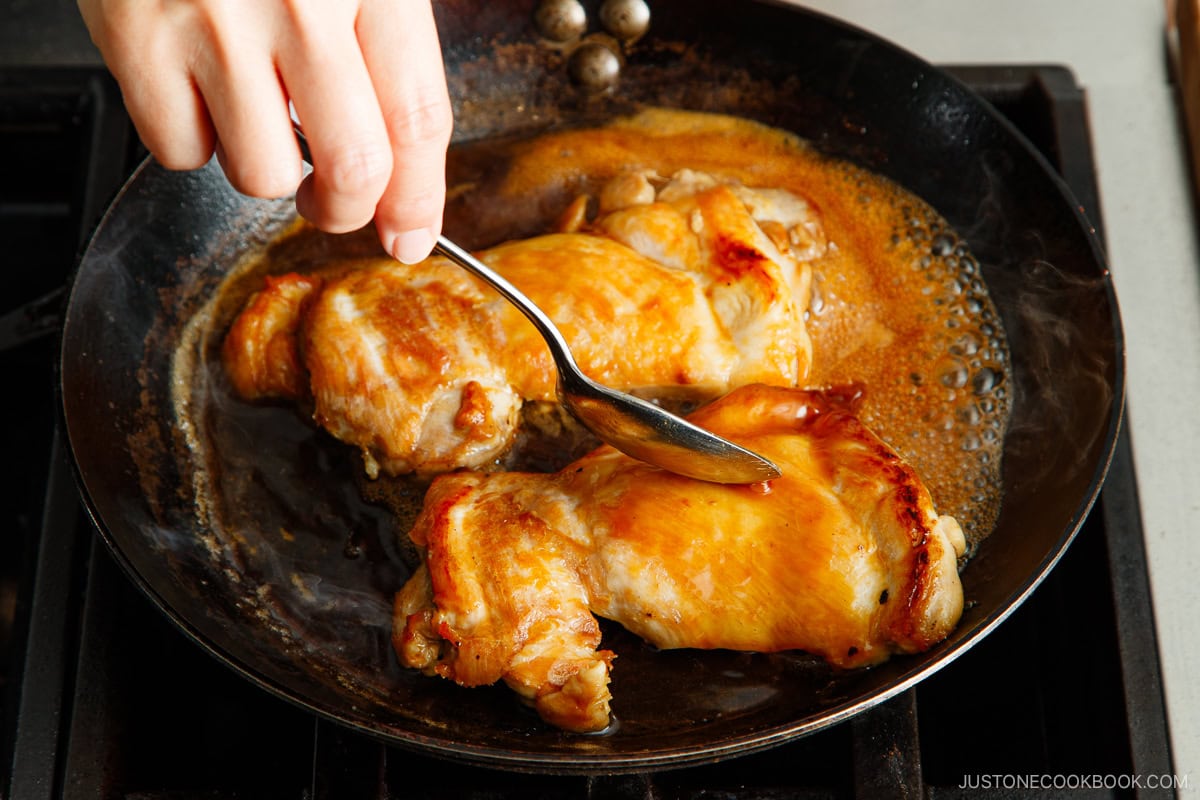
Assemble
Step 5 – Slice the chicken into bite-sized pieces and sear. Sear with a kitchen butane torch to enhance the flavor. You can also use a broiler in the oven.
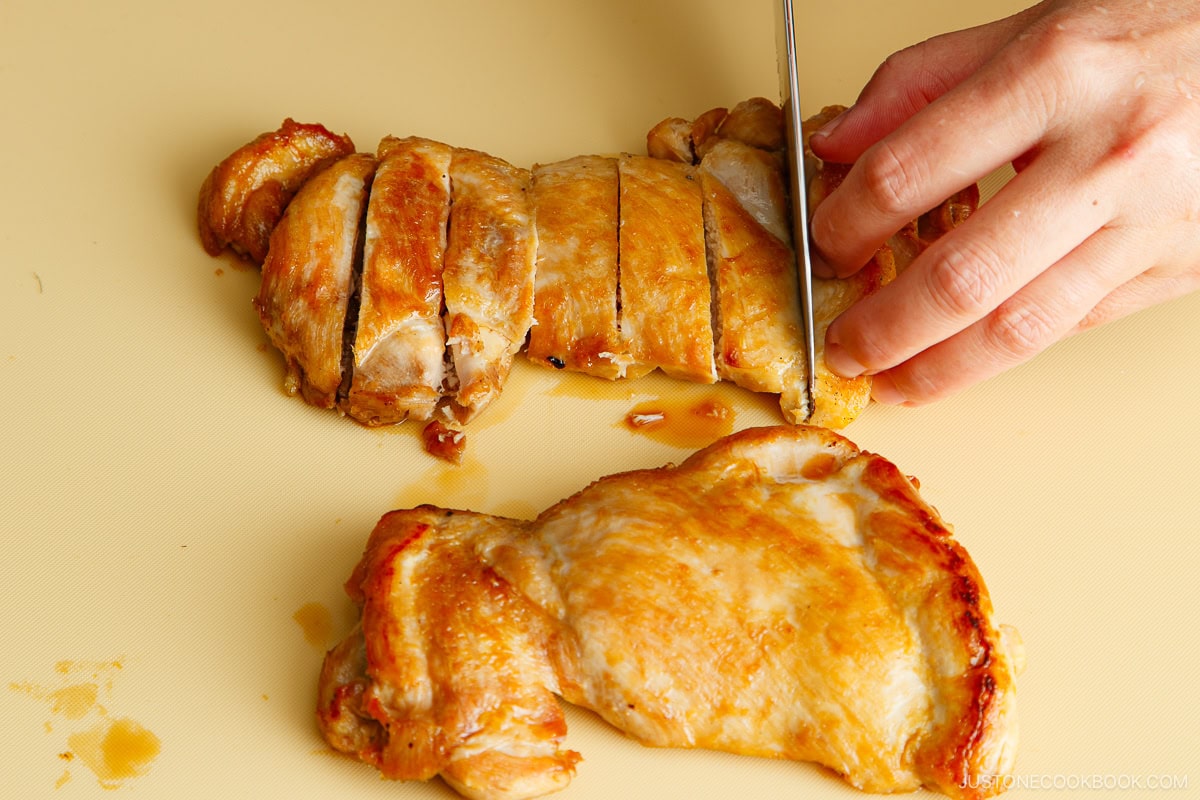
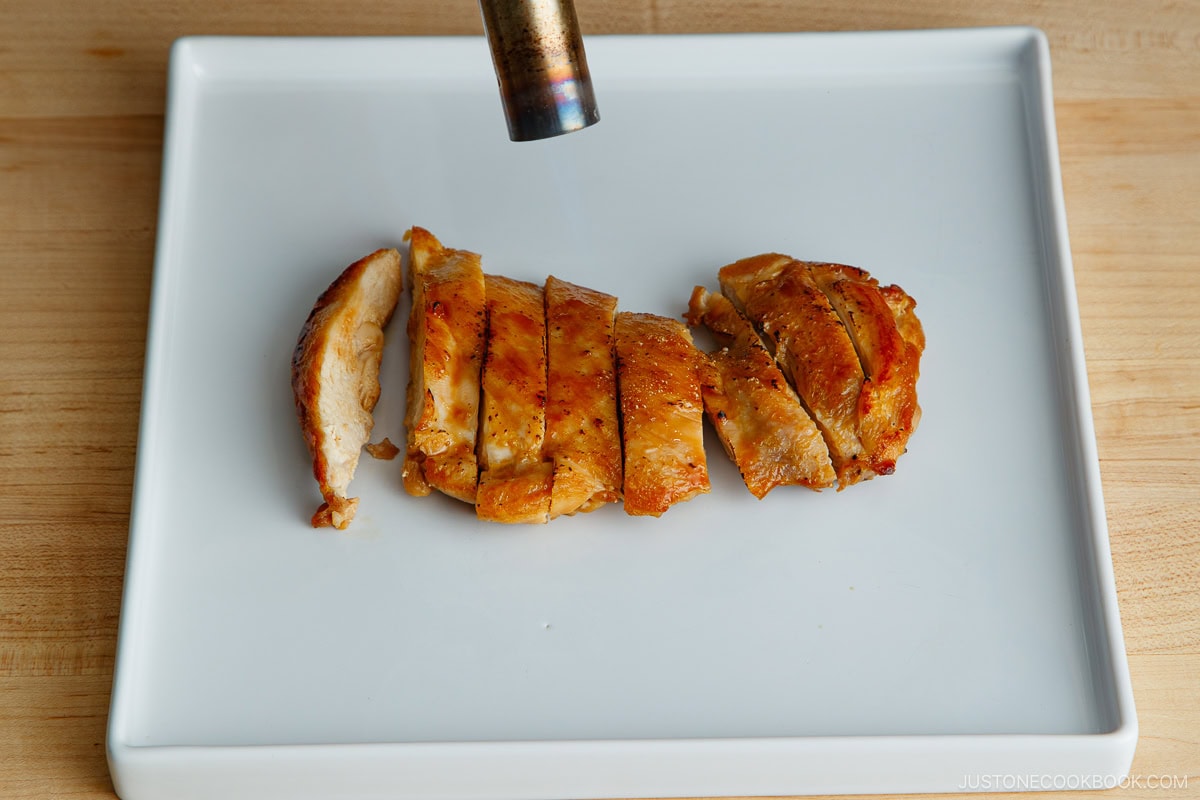
Step 6 – Serve and enjoy! Transfer to a plate or serve over steamed rice. and drizzle a tablespoon or two of the sauce on top.
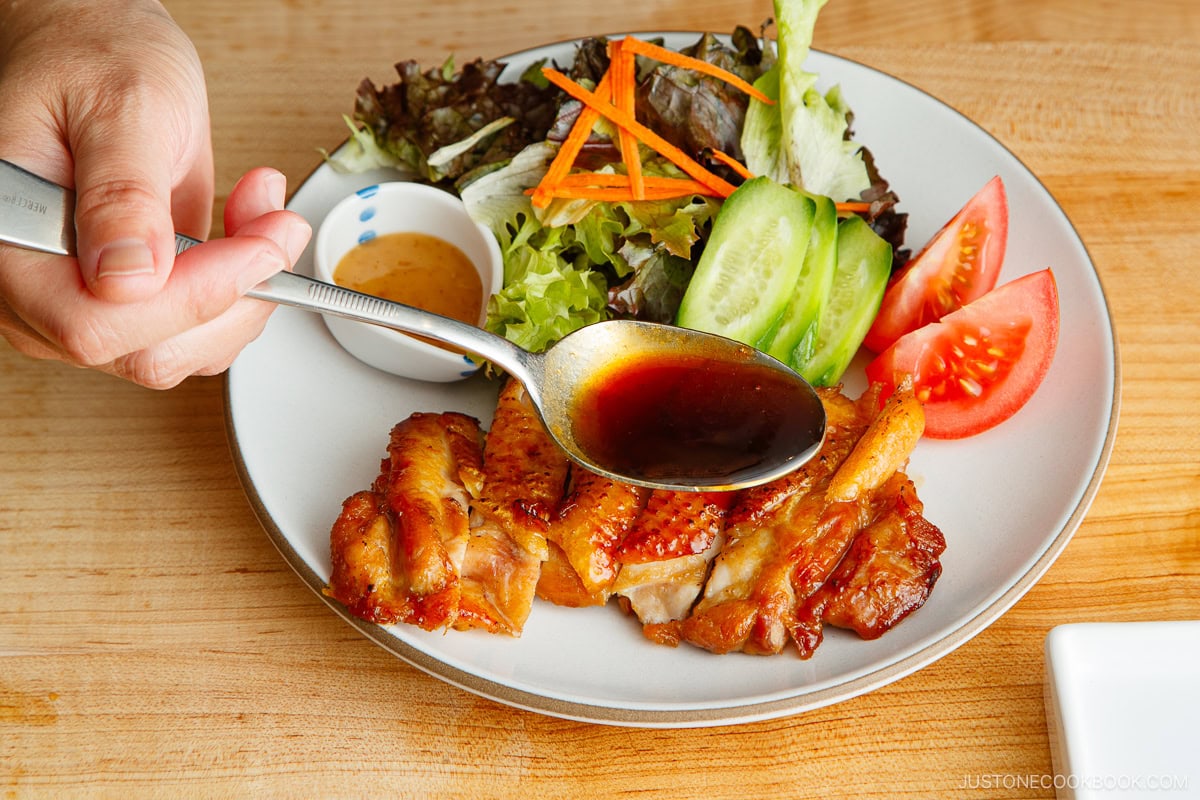
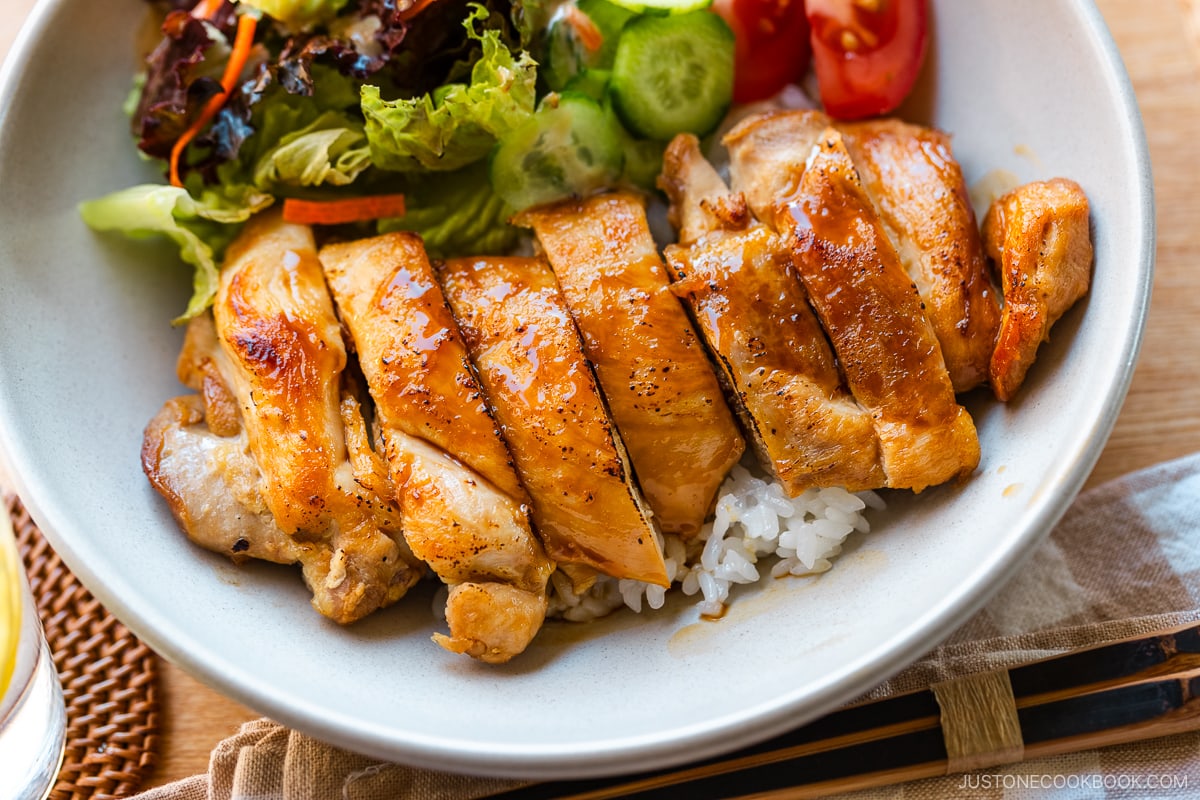
Nami’s Recipe Tips
- Score and flatten the thighs for an even thickness – This helps distribute the heat evenly and prevent overcooking for dramatically juicier chicken! It is an extra step, but it ultimately makes a difference. To score, cut slits across the meat every ½ inch (1.3 cm) without slicing all the way through. Make deeper slits on the chicken‘s thick parts and skip scoring the thin parts. After each cut, press open and flatten the meat with your fingers.
- Pan-fry to sear the chicken skin – To sear and brown the skin quickly, use a reliable frying pan or large skillet. Make sure the pan and oil are both hot before adding the chicken skin side down. Press the chicken down with a spatula and let it sear undisturbed until the skin crisps up and browned.
- Steam the chicken to cook it through – Steaming helps to cook thoroughly until the meat is no longer pink inside. Flip and cook covered on low heat once the chicken is browned. It’s best not to overcook the chicken as it will continue to cook with the sauce.
- Patiently spoon the teriyaki sauce on top – Once you pour the teriyaki sauce over the chicken, tilt the frying pan to spoon the sauce over it. Repeat until the chicken absorbs the delicious glaze and starts to shine. Remove it from the pan and reduce the sauce a bit more if it’s too thin.
- Let the sauce reduce and thicken naturally – It’s not necessary or advisable to use cornstarch as a sauce thickener. As the alcohol from sake and mirin evaporates, the sauce will naturally reduce and thicken with the sugar caramelizing during the simmering process.
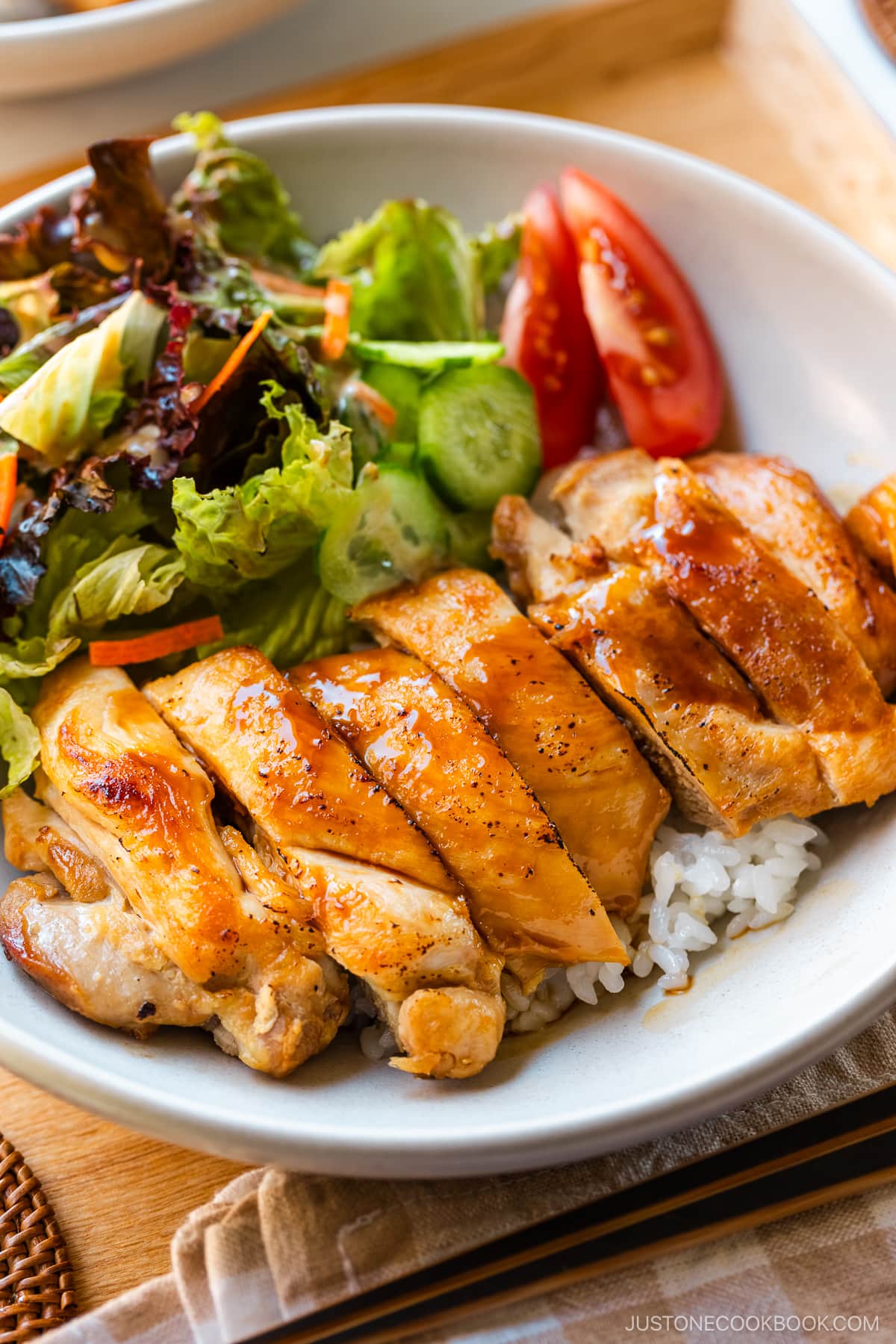
Variations and Customizations
- Play with the ratios of the sauce ingredients. My basic teriyaki sauce consists of two parts soy sauce, two parts sake, two parts mirin, and one part sugar (2:2:2:1). You can adjust the ratio to suit your taste. You can even make a big batch of Homemade Teriyaki Sauce ahead of time and store it in a jar in the refrigerator.
- Add grated ginger, grated onion, or minced garlic. You could add these optional ingredients to the traditional four-ingredient sauce for additional depth and zing. To follow the authentic Japanese flavor profile for this dish, I would not recommend adding rice vinegar, honey, brown sugar, sesame oil, apple cider vinegar, sesame seeds that you might see in some online recipes.
What to Serve with Chicken Teriyaki
Simple and bursting with sweet yet savory flavor, I believe anyone can cook this classic Japanese dish at home. Serve the Chicken Teriyaki with rice with a salad or steamed vegetables. Here are some side dishes that I like to pair with chicken teriyaki.
- With a vegetable side – I recommend Green Bean with Sesame Dressing or a simple Quick Blanched Broccoli with Sesame Oil to balance the meal.
- With a salad – I always serve a refreshing element like Japanese Cucumber Salad or Salad with Carrot Ginger Dressing to help cut the richness of the chicken.
- With soup – a comforting soup like Homemade Miso Soup or Vegetable Miso Soup rounds out the meal beautifully.
- With rice – I’ll show you How to Cook Japanese Rice in a Rice Cooker for perfect rice every time.
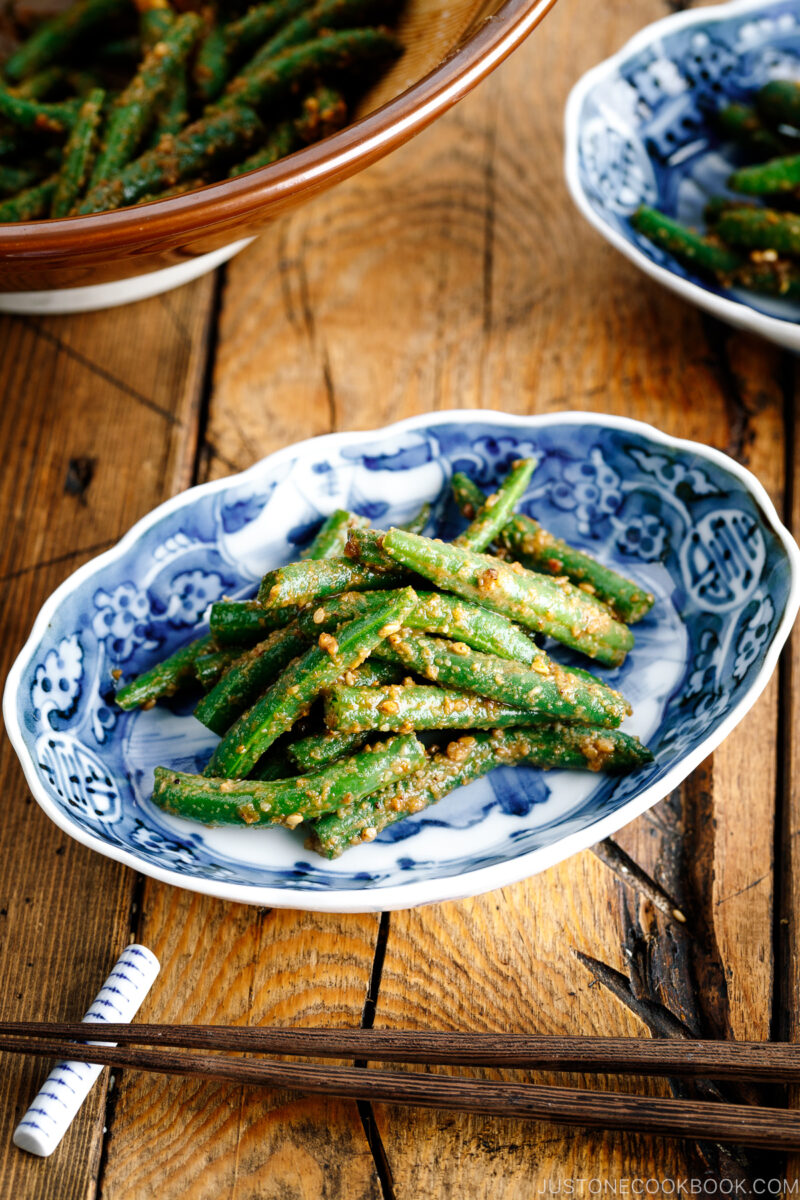
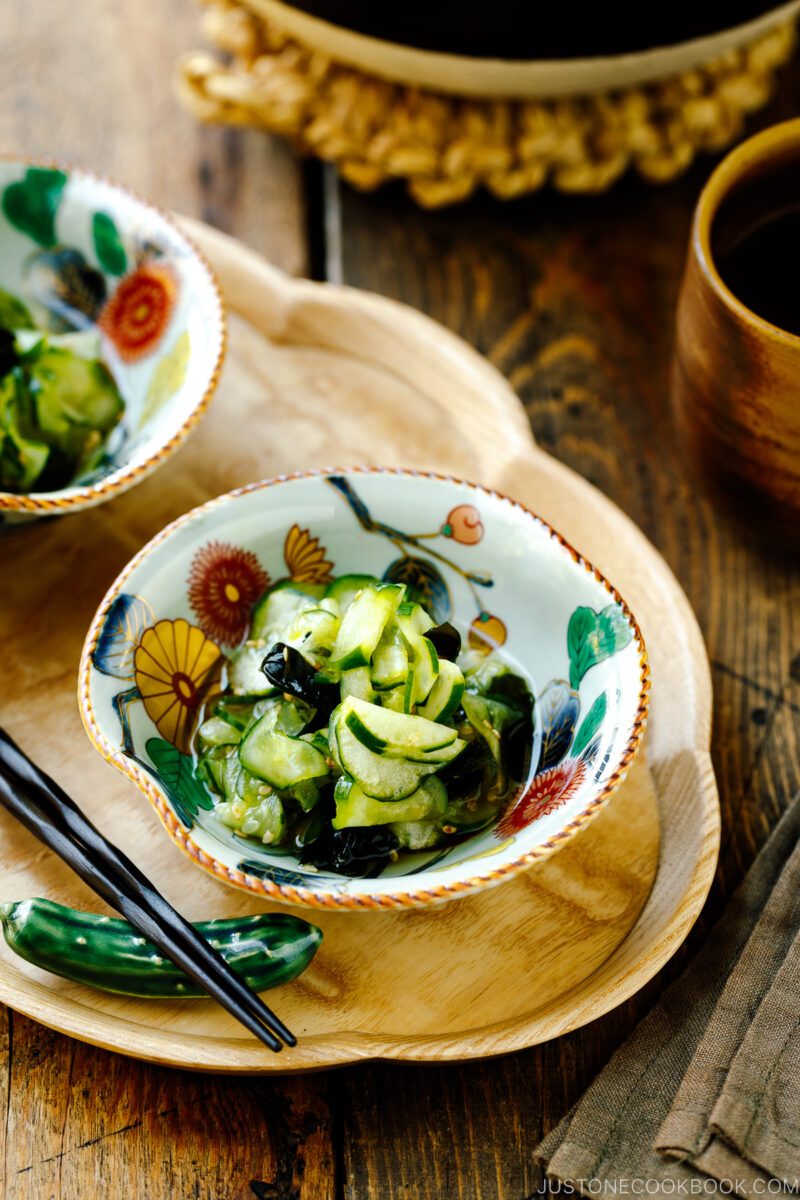
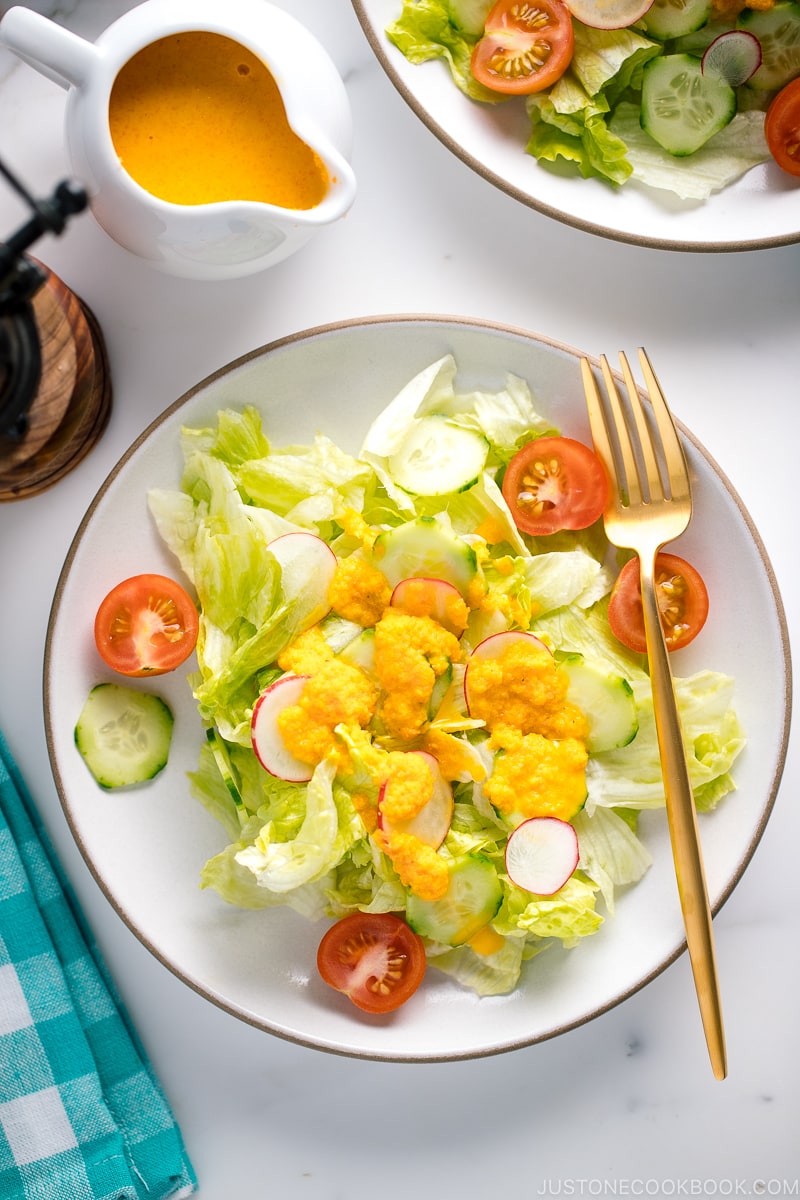
Storage Tips
To store: You can keep the chicken teriyaki leftovers in an airtight container and store in the refrigerator for up to 3 days and in the freezer for a month.
Frequently Asked Questions
You can use chicken breasts if that’s what you prefer. Just remember that chicken breasts have more fiber and tend to turn rubbery sooner than thighs. When cooking chicken, thighs are more forgiving than breasts. Thighs can withstand higher temperatures and longer cooking times, which is why thighs are ideal for this Chicken Teriyaki recipe. The fat from chicken thighs keeps the meat moist and tender throughout cooking, resulting in a juicier and more flavorful dish.
You may have cooked the chicken too long. You only need to cook the chicken thigh for 5 minutes on the skin side to sear it quickly, then flip over and steam it for another 3 minutes.
Also, be sure to use skin-on chicken thighs for the juiciest and most tender results. They don’t dry out quickly like chicken breast and can withstand higher cooking temperatures and times. Also, the skin provides a protective barrier that keeps the meat moist.
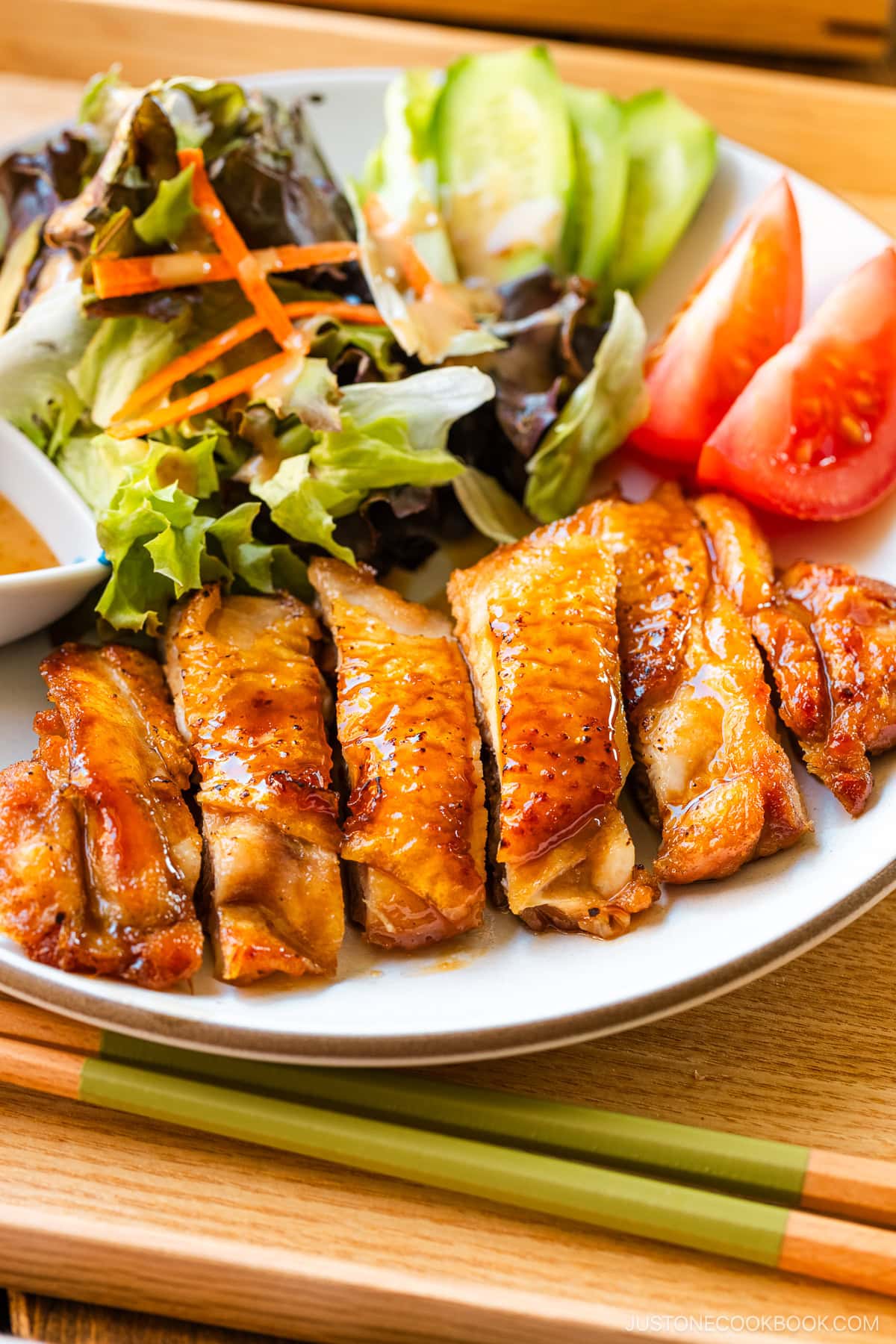
Readers’ Teriyaki Chicken Recipes
Teriyaki Chicken was the challenge recipe for the JOC Cooking Challenge June 2024. Check out the delicious dishes created by JOC readers!
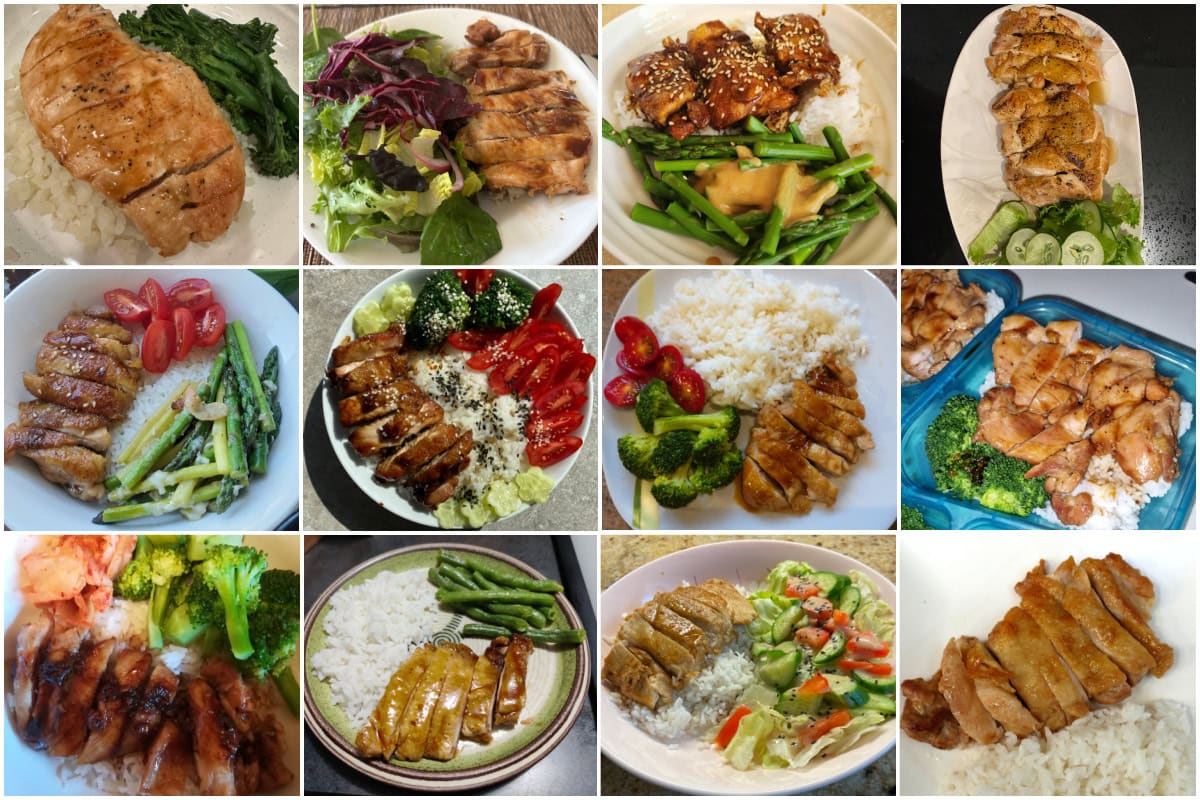
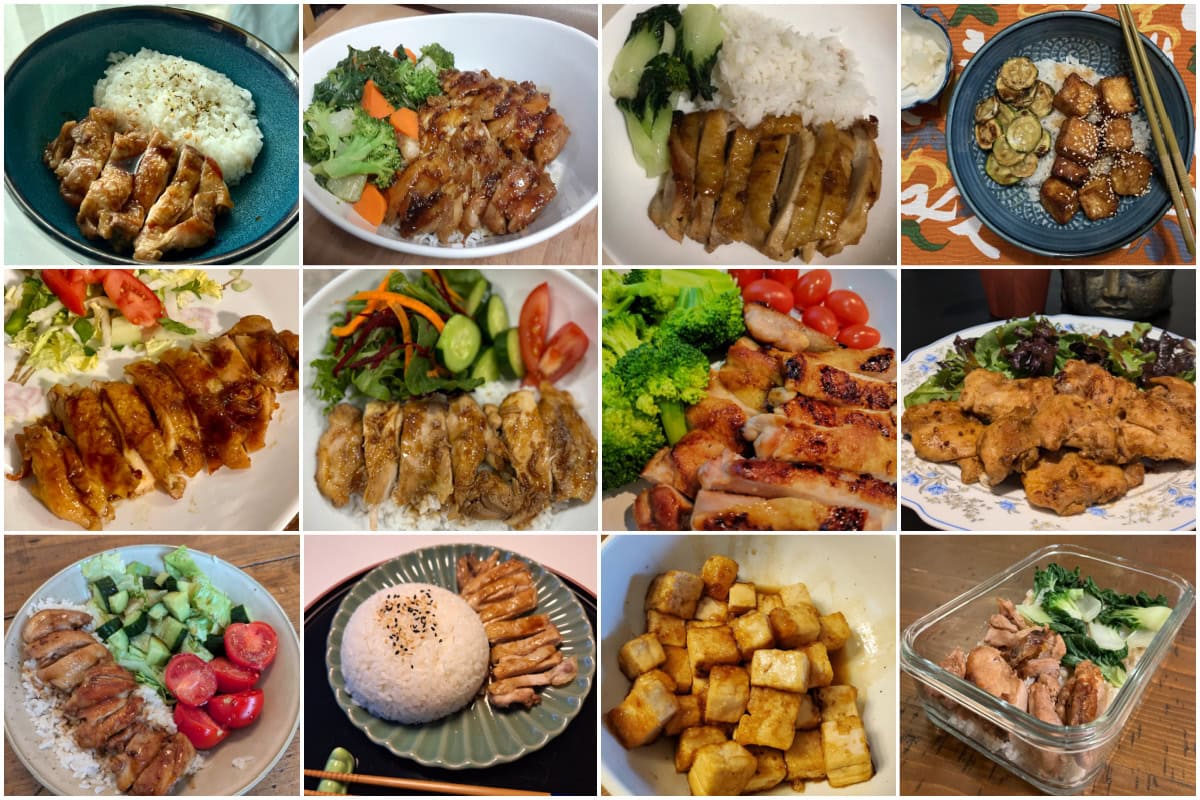
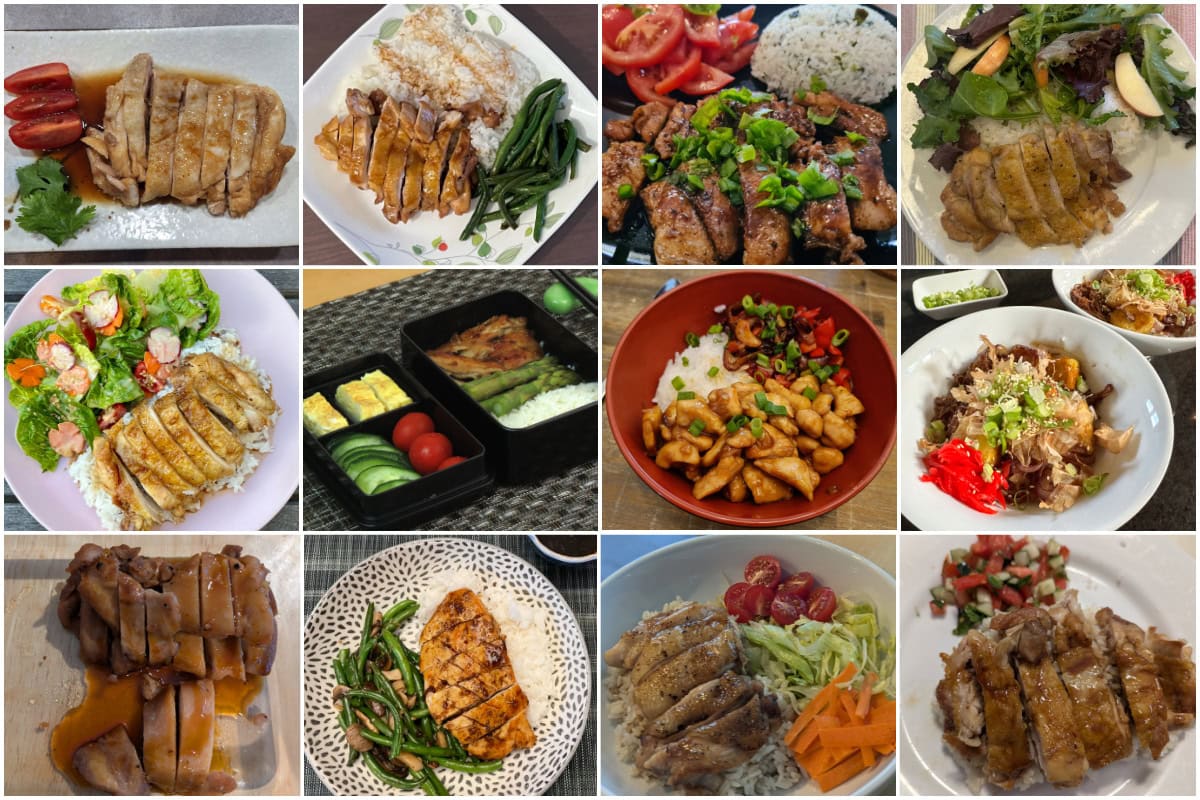
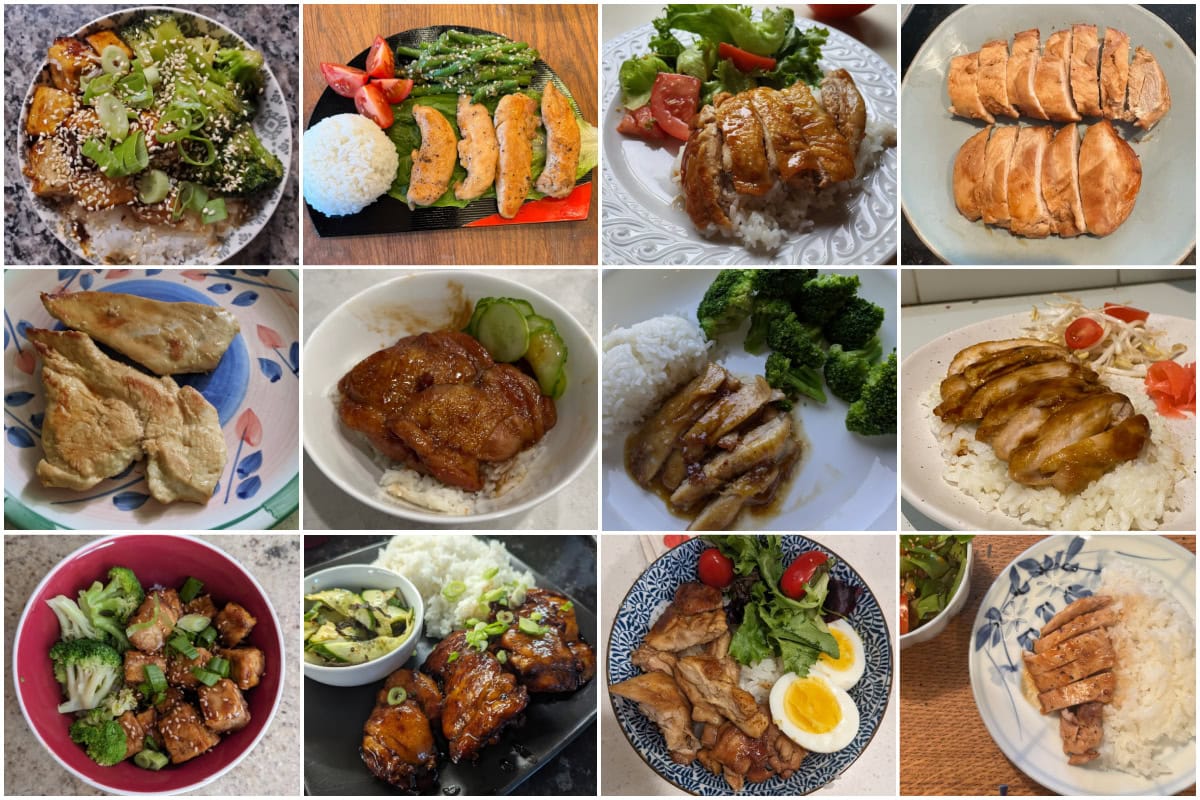
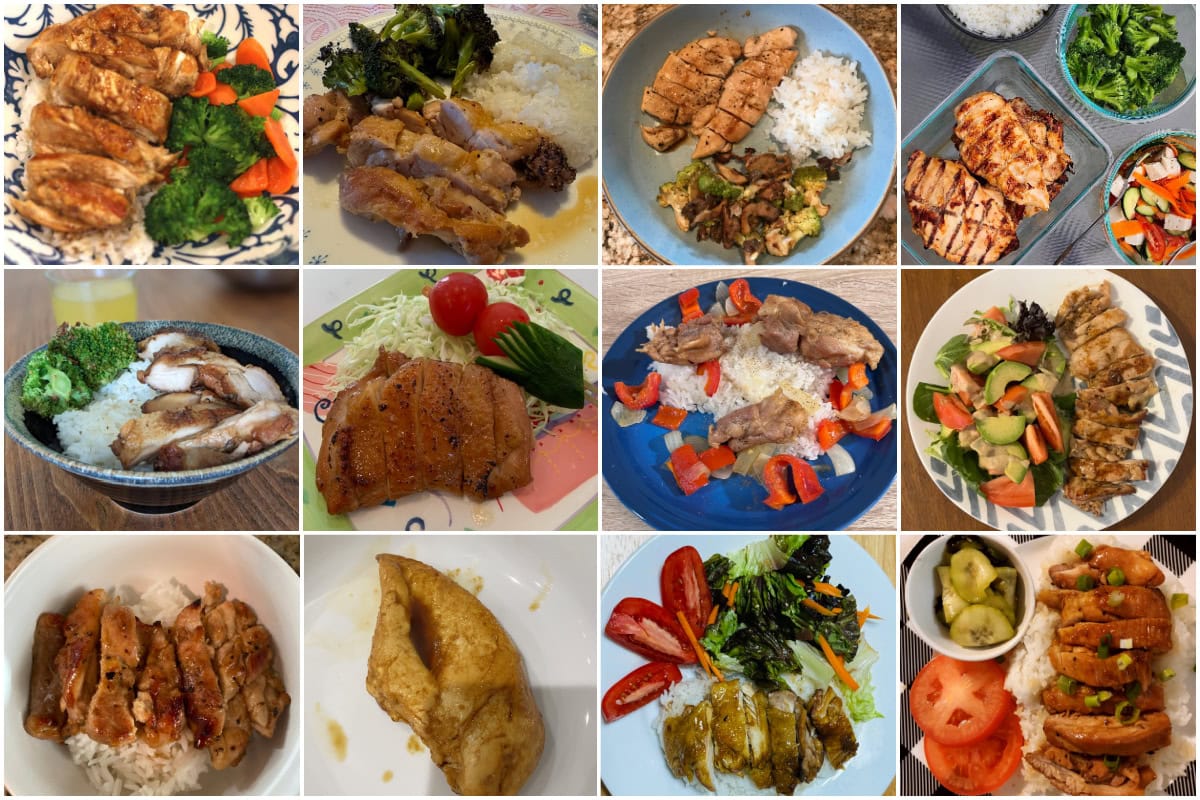
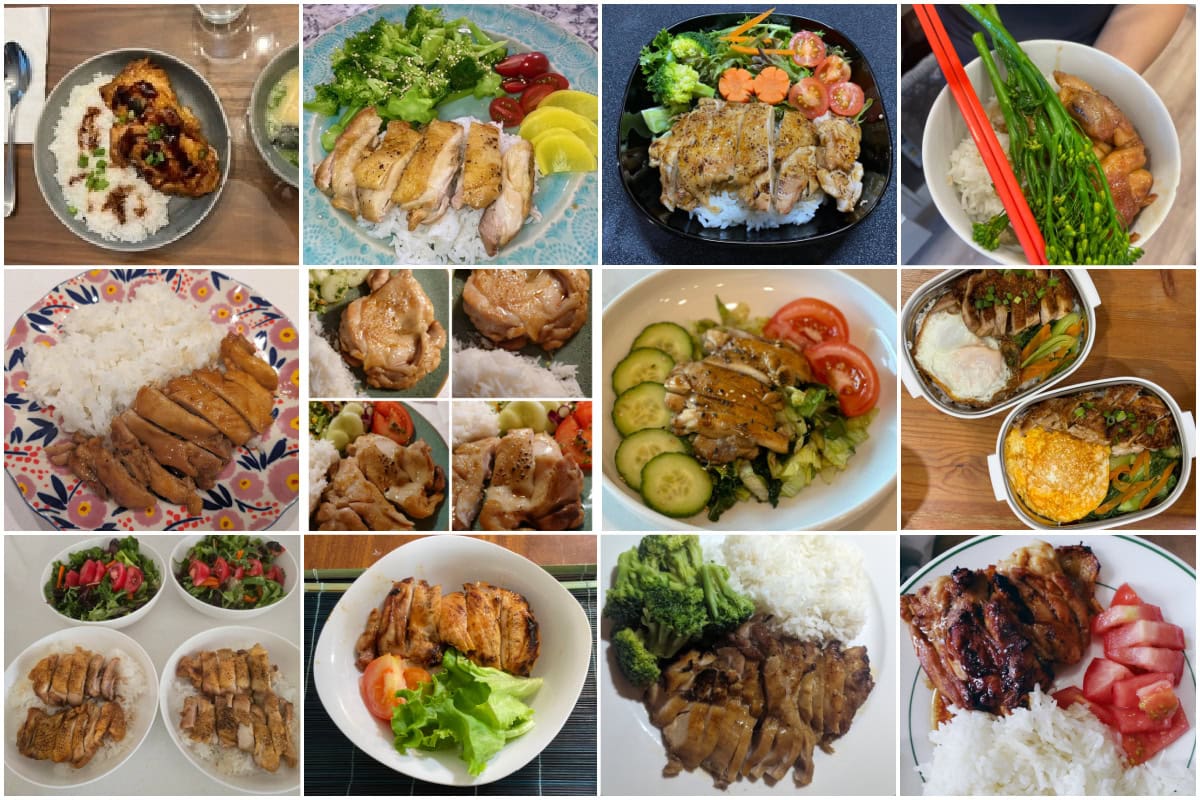
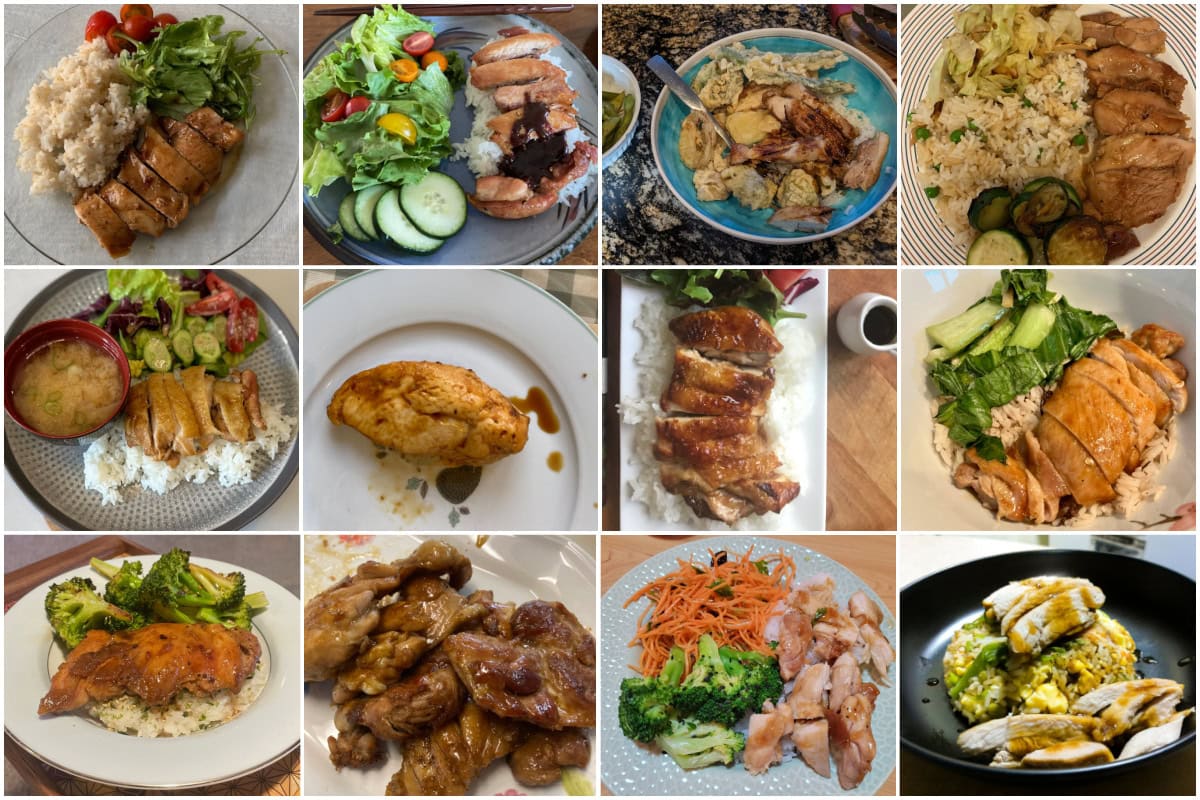
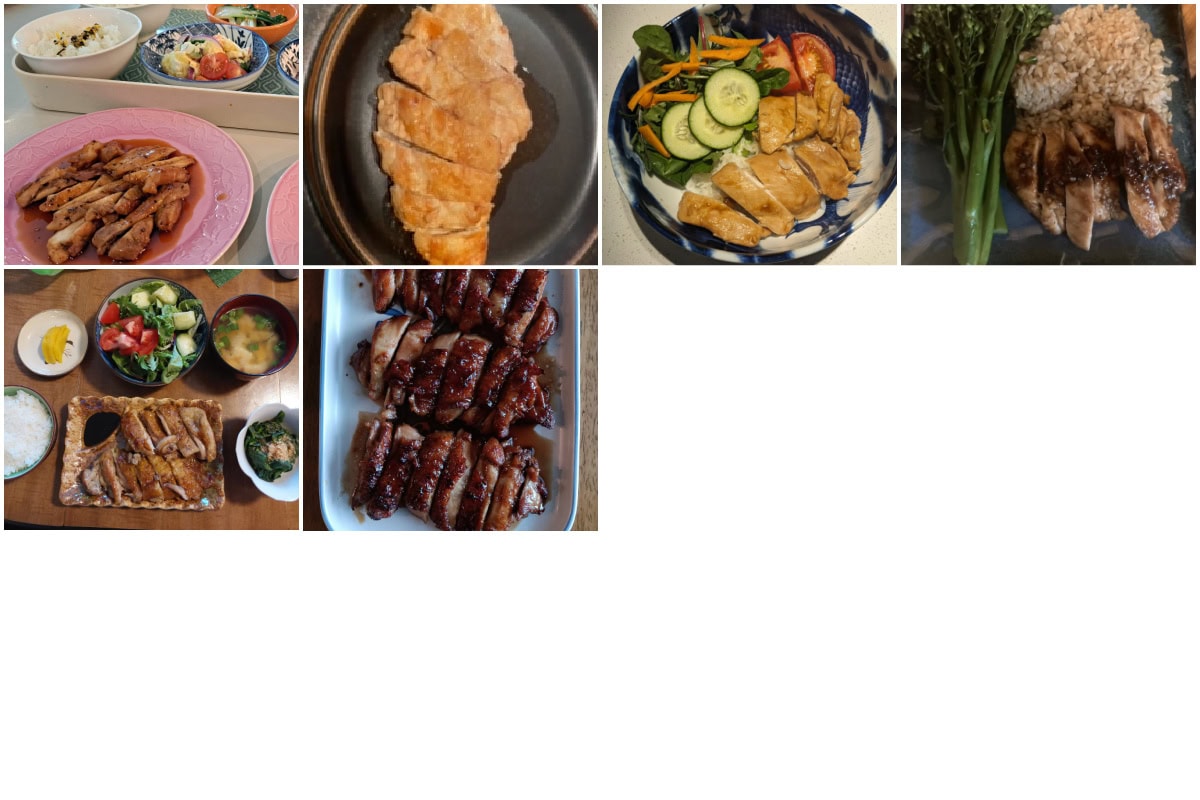
More Chicken Recipes
If you love this Chicken Teriyaki recipe, you’re in for a treat with these other irresistible Chicken recipes.
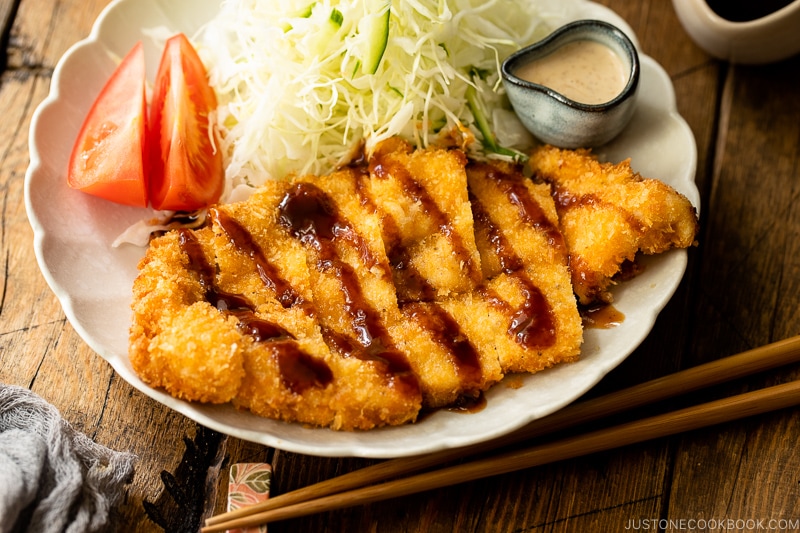
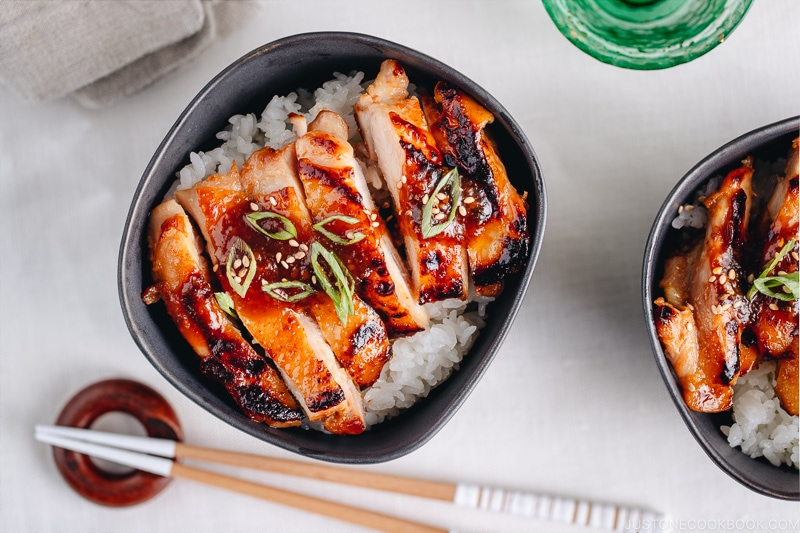

Chicken Teriyaki
Video
Ingredients
For the Chicken
- ¾–1 lb boneless, skinless chicken thighs (I highly recommend using skin-on, boneless chicken thighs if you can find them)
- ⅛ tsp Diamond Crystal kosher salt
- ⅛ tsp freshly ground black pepper
- 1 Tbsp neutral oil (for cooking the chicken)
Instructions
- In Japan, we use boneless, skin-on chicken thighs for this dish because the flavorful skin provides a protective layer, keeps the meat juicy, and helps the delicious glaze adhere to the chicken. Thighs are more forgiving to cook than chicken breasts, too. Read more about it in the blog post above.For this recipe, I focus on skinless and boneless thighs since that‘s how they‘re commonly sold in the US. However, if you have the chance, I encourage you to try my skin-on recipe at the end of the instructions below.
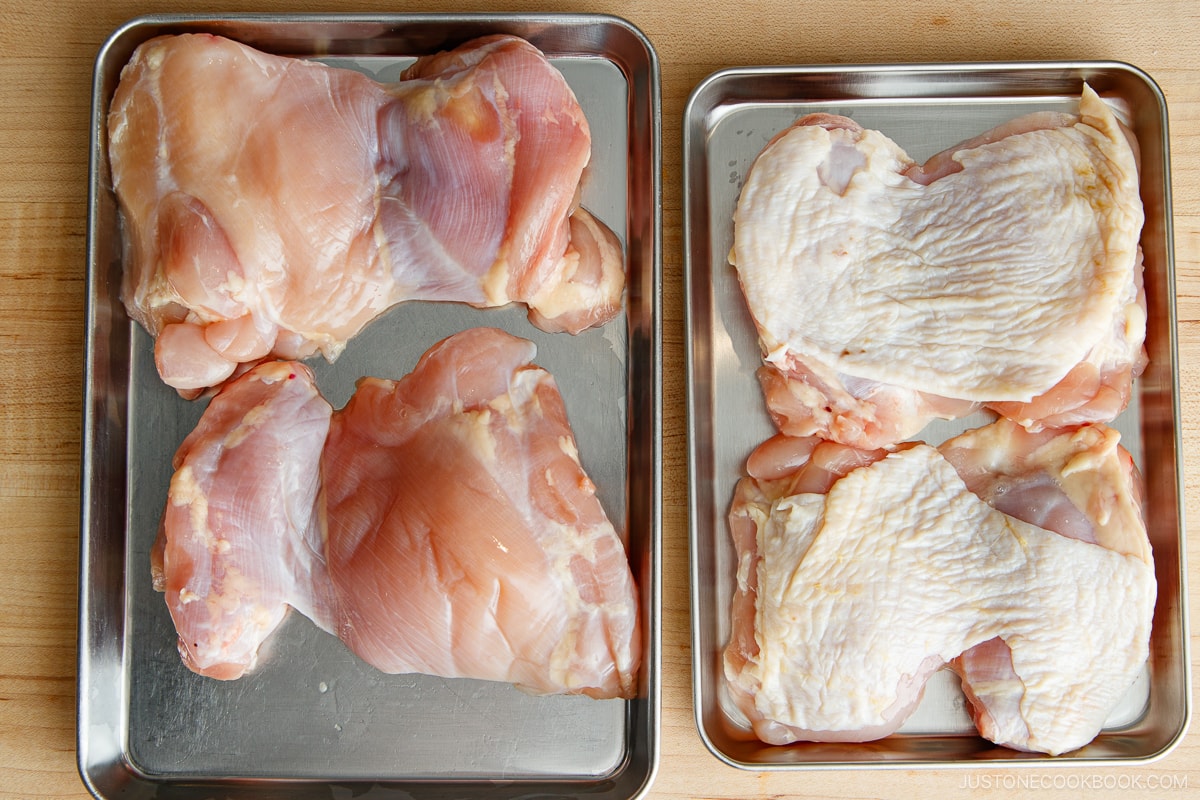
- Now, gather all the ingredients.
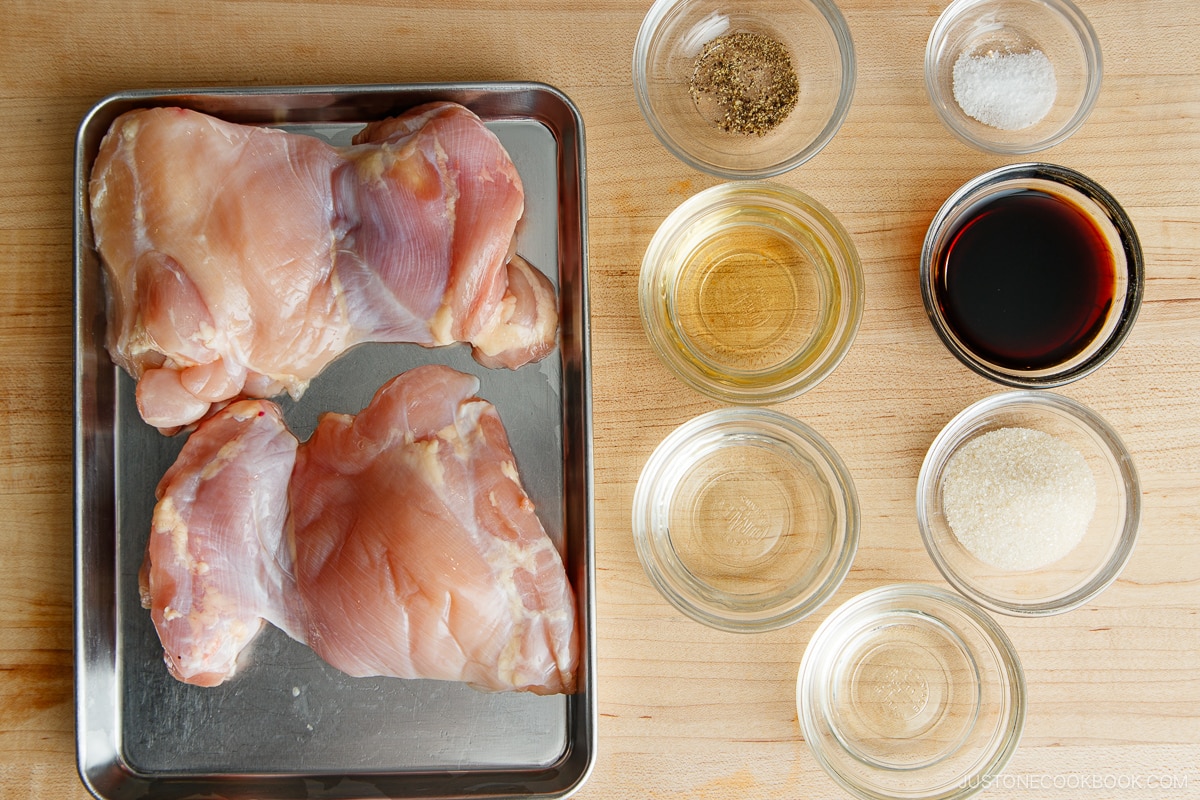
To Mix the Teriyaki Sauce
- In a small microwave-safe bowl, combine the sauce ingredients: 2 Tbsp soy sauce, 2 Tbsp mirin, 2 Tbsp sake, and 1 Tbsp sugar.
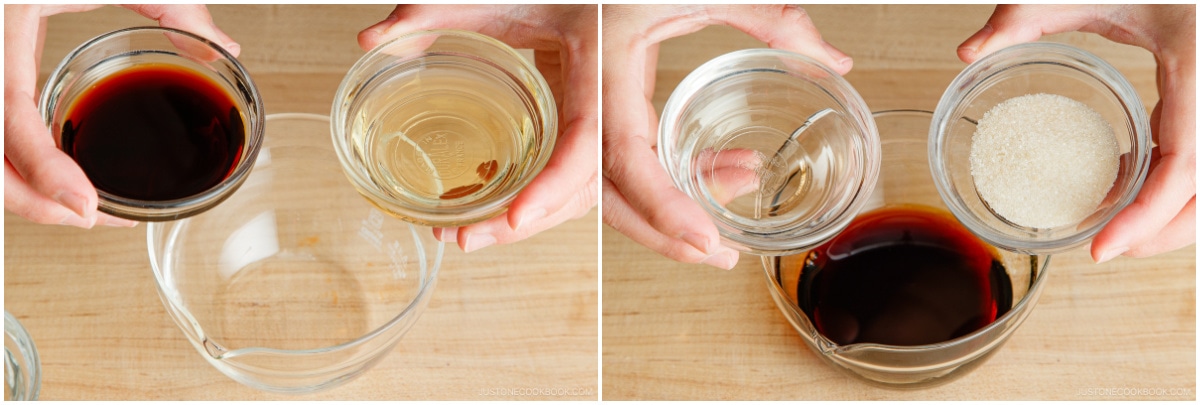
- Microwave the sauce until hot. Mix well to dissolve the sugar and set aside.
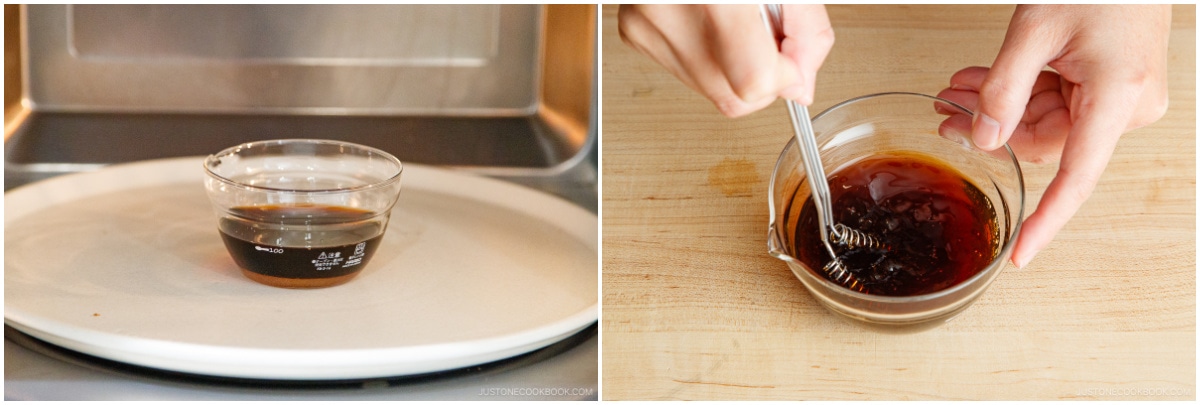
To Prepare the Chicken
- Place ¾–1 lb boneless, skinless chicken thighs smooth side down on a cutting board. Now, use the scoring method to create an even thickness so the thighs cook evenly. First, cut slits across the meat every ½ inch (1.3 cm) without slicing all the way through. Note: Do not use a meat mallet/tenderizer for this important step, as you may damage the meat.
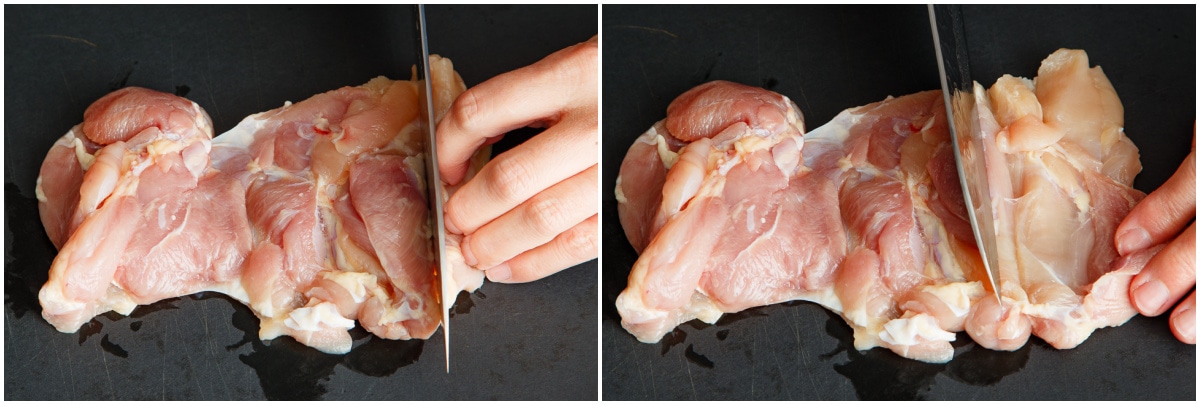
- Make deeper slits on the chicken‘s thick parts and skip scoring the thin parts. After each cut, press open and flatten the meat with your fingers. In the below images, you can see how I scored (left) and flattened (right) one piece. Once you finish scoring, check again to make sure the thigh has an even thickness. Repeat with the rest of the thighs.
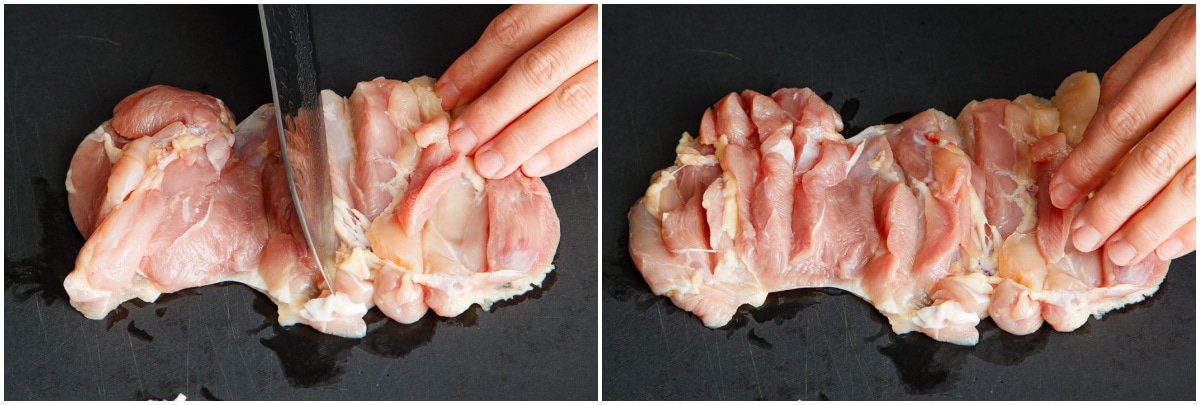
- Lightly season the chicken pieces with ⅛ tsp Diamond Crystal kosher salt and ⅛ tsp freshly ground black pepper.
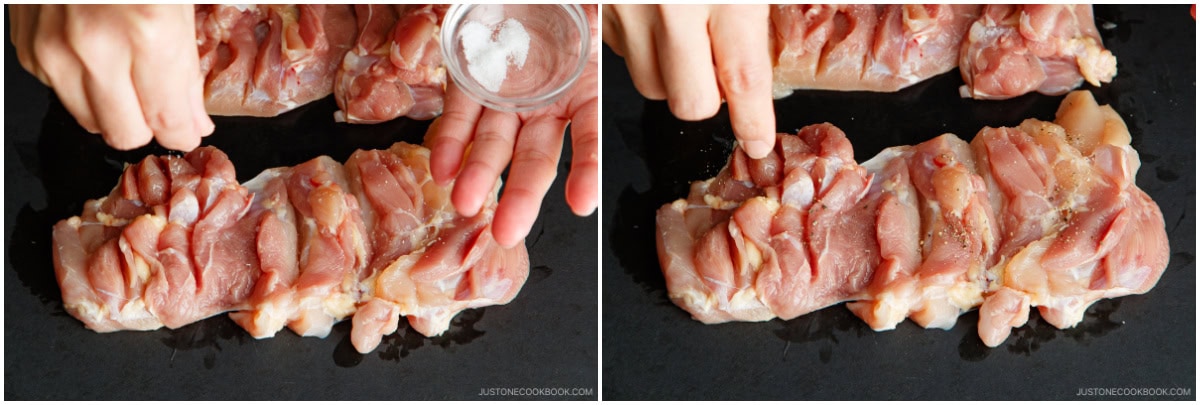
To Sear the Chicken
- Heat a large frying pan over medium to medium-high heat. When the pan is hot, add 1 Tbsp neutral oil. When the oil is hot, place the chicken smooth side down in the pan. Note: The bottom side will be the presentation side.
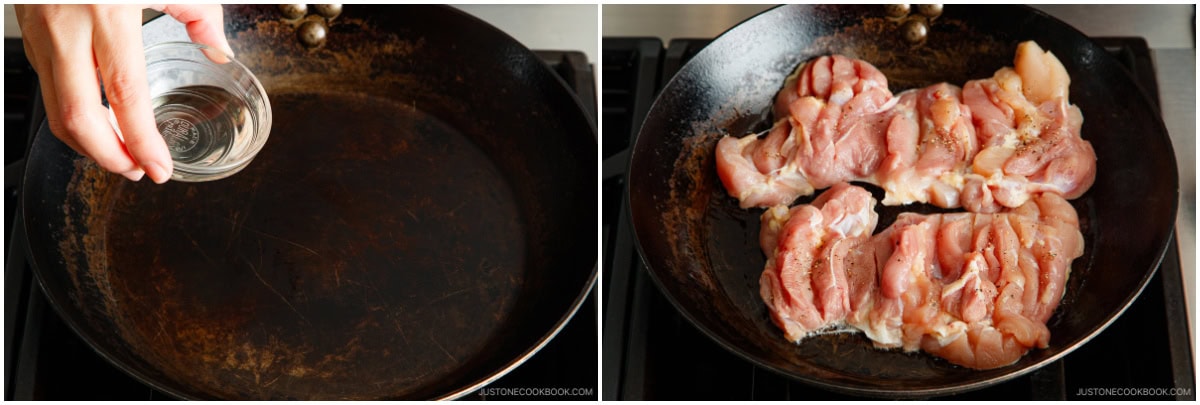
- Cook the chicken for 5 minutes (set a timer). Immediately, press down hard on the chicken with a spatula for 5–10 seconds to give the presentation side a nice sear. The right image below shows what the chicken looks like after 5 minutes of cooking; please adjust the time based on your stove and cookware.
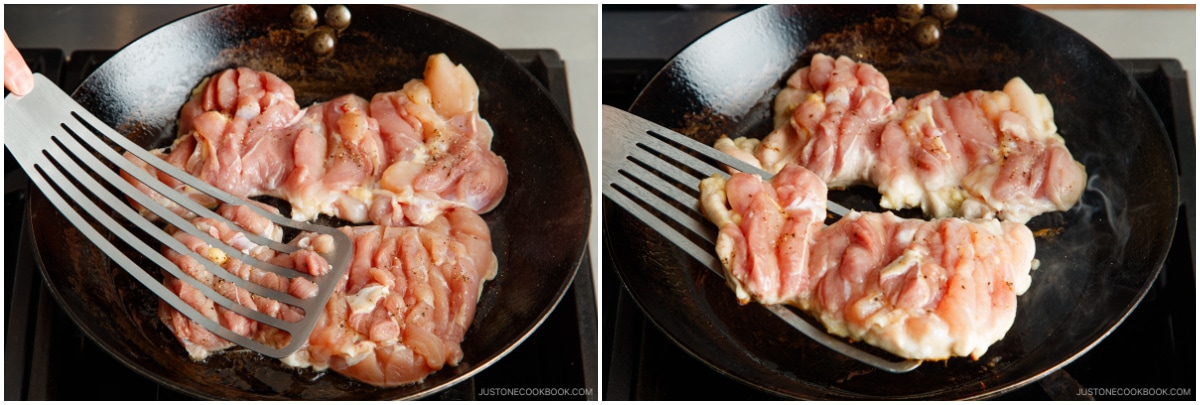
- Flip over the chicken. Immediately press it down again with the spatula for 5–10 seconds.
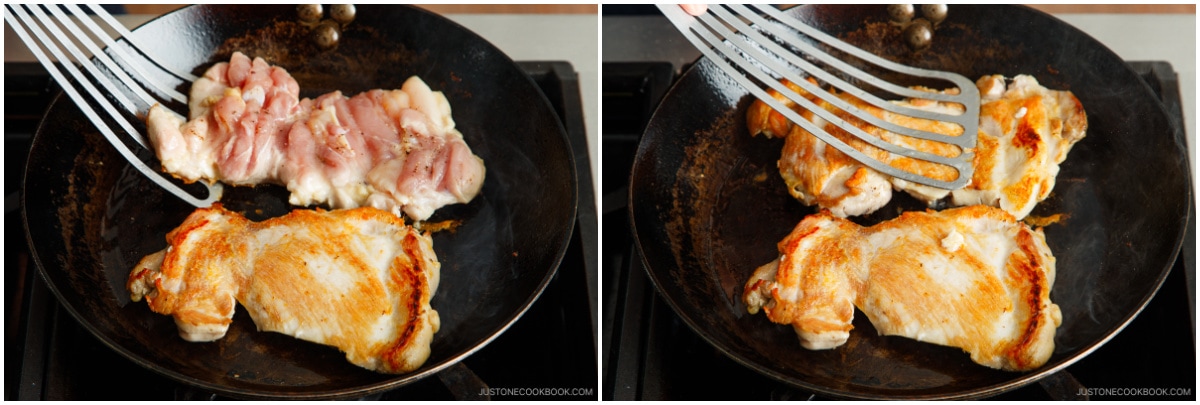
- Switch to low heat, then cover with a lid and steam the chicken for 3 minutes.

- Open the lid. Use a paper towel to wipe the excess grease and protein from the pan. This helps create a more transparent sauce.
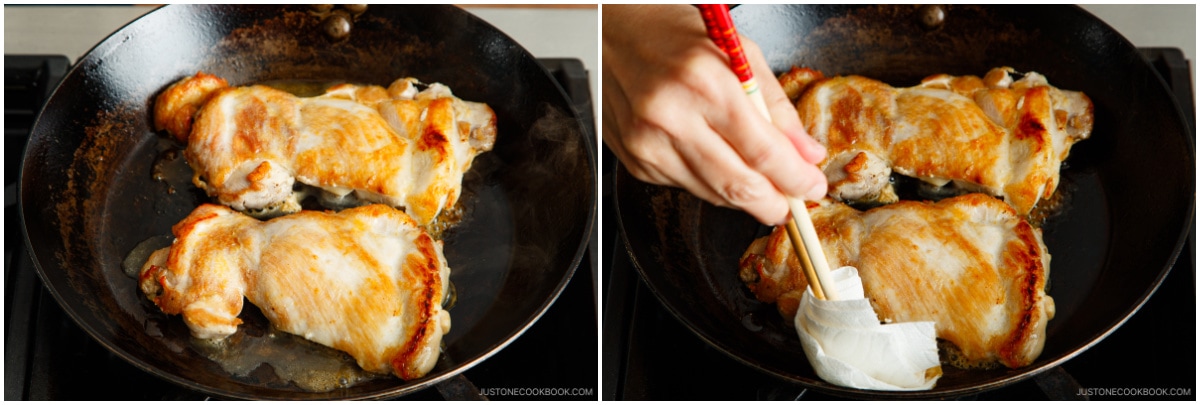
To Add the Teriyaki Sauce
- Now, increase the stove‘s heat to medium and add the teriyaki sauce to the pan. Tilt the pan and frequently spoon the sauce over the chicken.
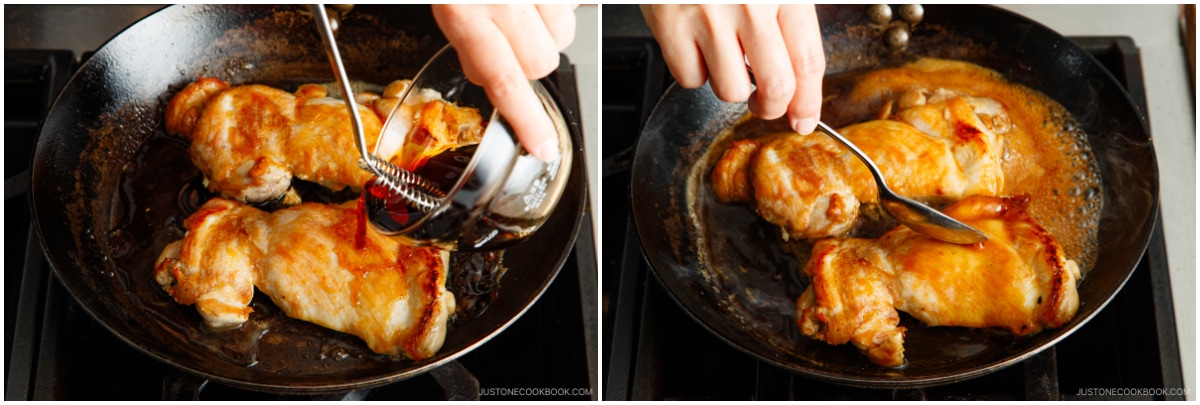
- When the chicken is well coated with sauce and cooked through, transfer it to a cutting board.
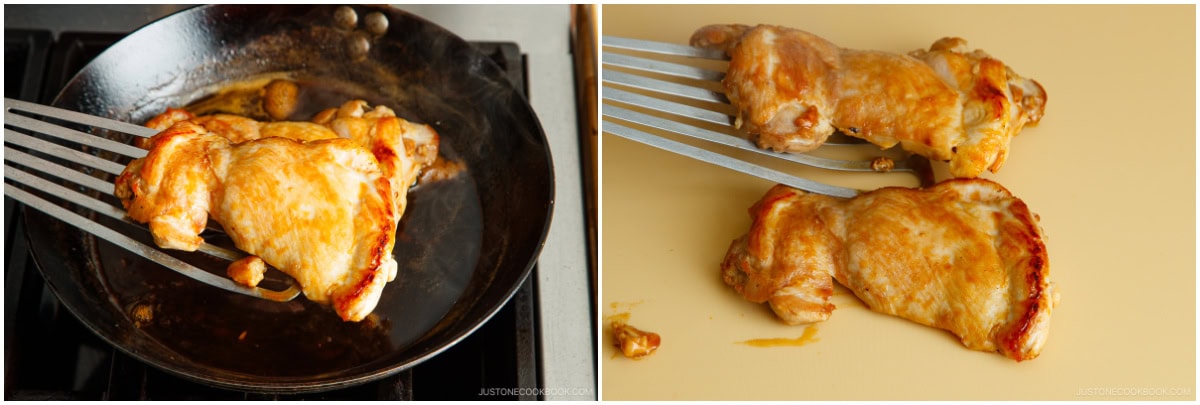
- Continue cooking the sauce until it's thick enough to your liking. Then, transfer it to a bowl. Remember to stop cooking while the sauce is slightly thin because the residual heat will continue to thicken the sauce. If you‘d like it thicker, reduce the sauce for 2–3 minutes longer.
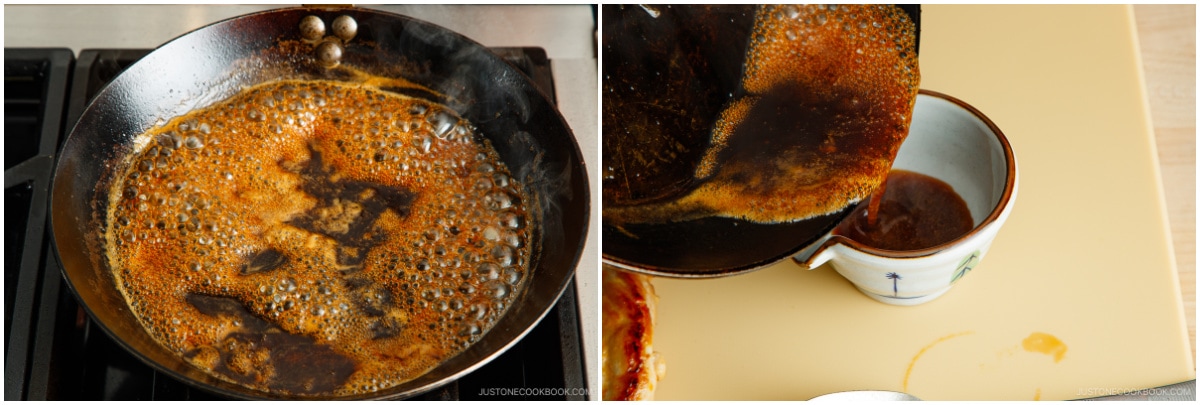
- Slice the chicken into bite-sized pieces. Transfer them to a ceramic plate. Sear with a kitchen butane torch to enhance the flavor. You can also use a broiler in the oven.
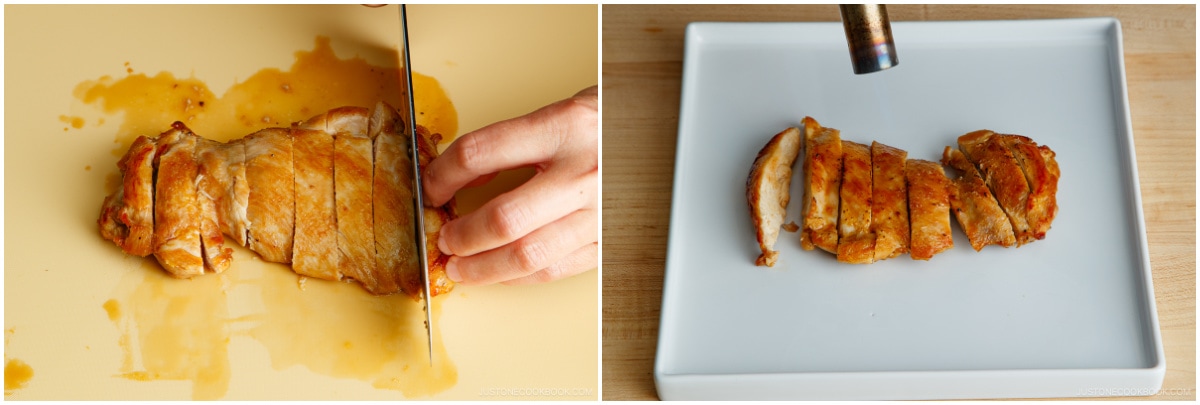
To Serve
- Serve on a plate with the sauce drizzled on top. You can also serve it over steamed rice with the sauce drizzled on top, as I did here. I also served green salad and tomato wedges on the side.
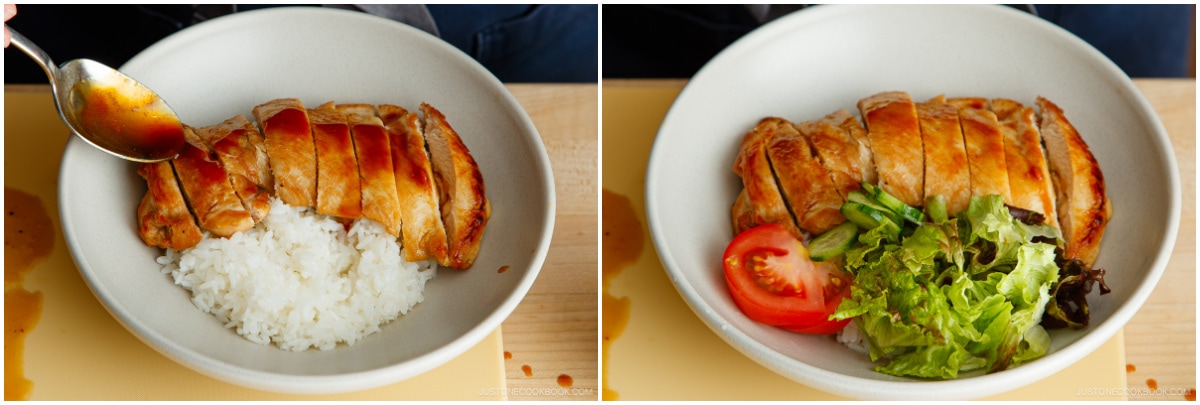
To Store
- You can keep the leftovers in an airtight container and store in the refrigerator for 3 days or in the freezer for a month.
To Cook Skin-on Chicken Thighs
- If your ¾–1 lb skin-on chicken thighs are bone-in, ask your butcher to remove the bone or you can debone them yourself. Place the thigh meat skin side down on a cutting board. To even the thickness, make slits on the meat every ½ inch (1.3 cm) without cutting all the way through. Cut deeper slits on the thick parts and skip scoring the thin parts. As you score, press open the meat to flatten it. Once you finish scoring, check again to make sure the meat has an even thickness. Repeat with the rest of the thighs.
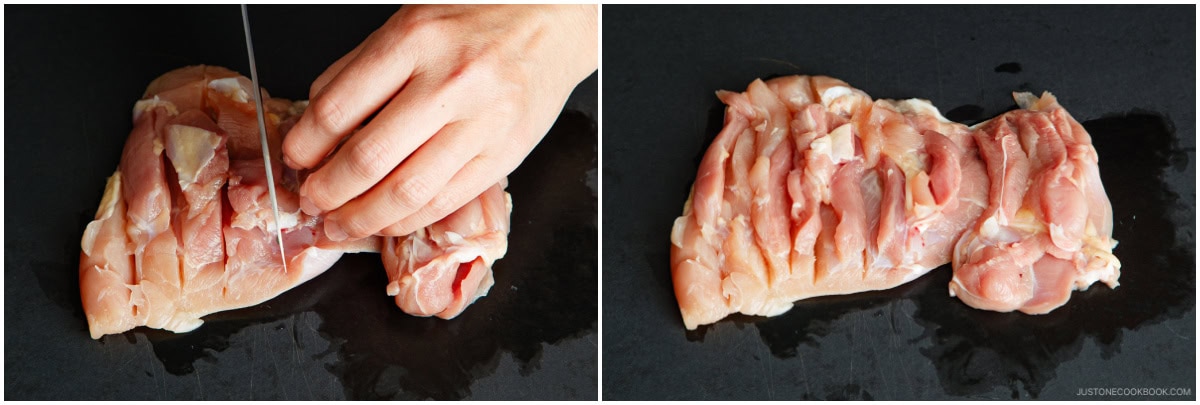
- Place the thighs skin side down in a hot frying pan and cook using the same method as described above.
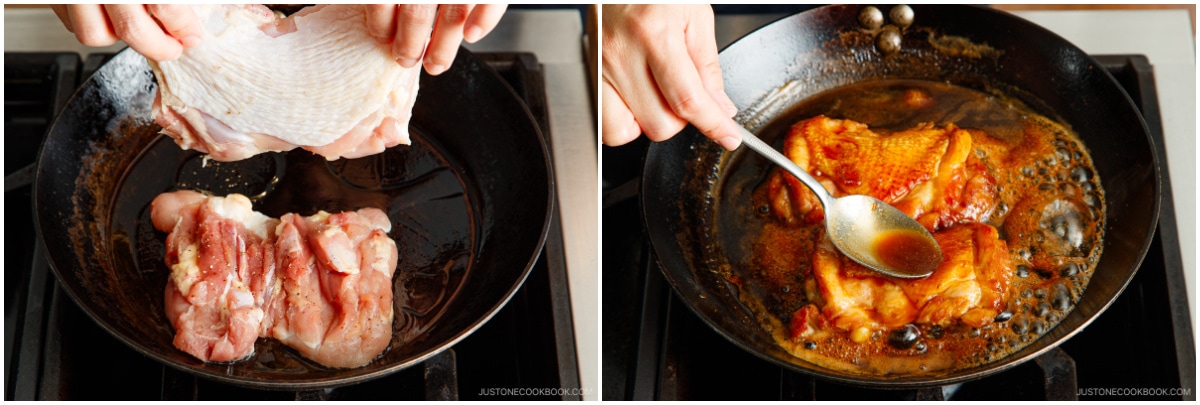
- Slice the chicken into bite-sized pieces. Transfer them to a ceramic plate. Sear with a kitchen butane torch to enhance the flavor. You can also use a broiler in the oven. Serve on a plate and drizzle the sauce on top.
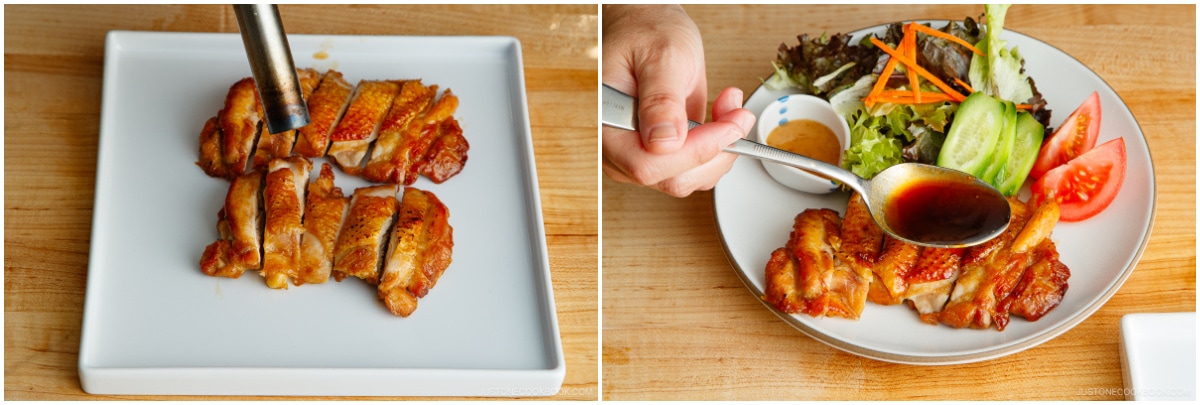
Nutrition
Editor’s Note: The post was originally published on March 22, 2012. It was updated with a revised recipe and new images on April 14, 2024, and with a new video on May 31, 2024. It was republished with more helpful information on January 8, 2025.
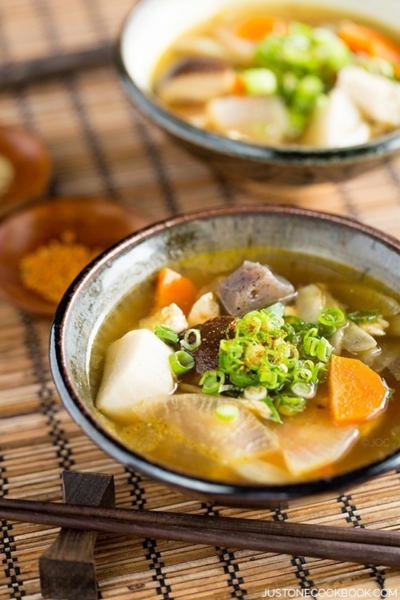
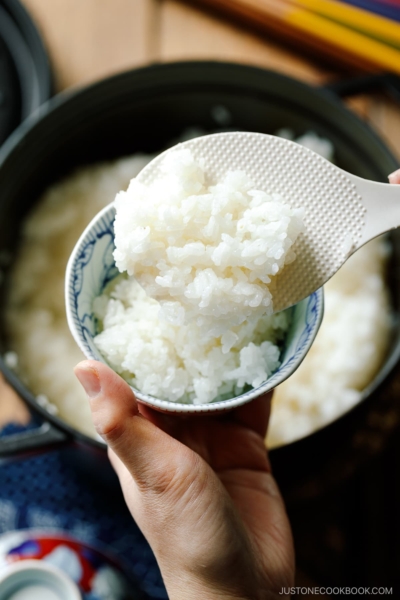
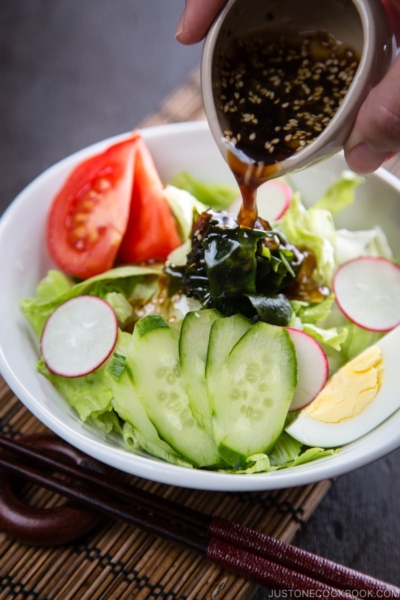
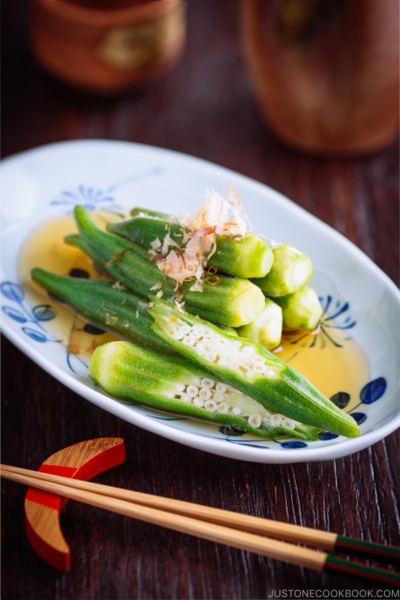





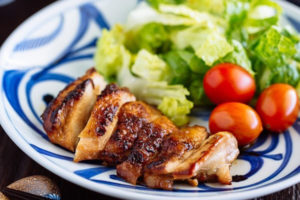
Hi, Nami,
Today I tried teriyaki chicken and apple salad, it work. My family all liked it. Thanks again. I will try the other fish recipe.
Hi Lf! Thank you for trying the teriyaki chicken recipe. I’m so happy to hear you liked it! 😀 Hope you like the fish recipe too. Thank you for your feedback!
Hi Nami,
This is the first time I visit your blog, thanks for your Japanese food recipe and full detail preparation procedure. I loved Japanese food very much, and now I can try myself. Can we use the teriyaki sauce again to cook the chicken? Thanks.
Hi Lf! Welcome to my blog! I’m happy to hear you like Japanese food, and hope my recipes are useful. 🙂 About re-using the sauce, I don’t recommend re-using the marinade/sauce from cooking the meat. Plus, most of the liquid/marinade should be evaporated while cooking. Hope that helps. 🙂
If Sake it not available in my region , by which ingredient I may replace it? Thanks
Hi Marie! You can omit sake if you cannot find it. We only need small portion, and it is not worth buying a new bottle if you only make this dish. 🙂 You can use dry shelly as a substitute. If you plan to cook other Japanese food, sake is in many of recipes so you might want to get one. You can find it in Japanese or Asian grocery stores. Hope this helps. 🙂
https://www.justonecookbook.com/pantry/sake/
Made your chicken teriyaki recipe tonight. I normally broil my chicken in the oven and tried your method of using the fry pan and must say that it was very good. It was my first time that I grated onion and it brought a different flavor to the dish. Grating the onion was a bit of a challenge since it is quite slippery(not like daikon). Any feedback to make the grating process easier?
Thank you.
Hi Mae! Thank you so much for trying this recipe! I hope you enjoyed it. Adding grated onion gives nice texture to the sauce and when it’s cooked it gives sweet flavor.
Agree, it’s a bit challenging to grate onion. Some brand of grater works better than others, as well. I have one grater that has a handle for vegetable so I can grate without worrying about my finger. To avoid onion getting separated, you can also keep the core (don’t chop off) when you grate, so it won’t be separated… I hope you understand what I mean… 🙂
Hope this helps!
this looks a-mazing!!!! about to head to the asian store to get me some sake and mirin. my mom would be so ashamed to know i don’t have soy in the house… anyway, got rice cooking away. gonna serve with a side of bok choy. can’t wait to try this!!!! thank you so much for your blog ;o) happy holidays!!!
I’m happy you decided to try this recipe, and thank you so much for stopping by to leave your feedback. I hope your Chicken Teriyaki turned out well. 🙂
Well, when I think of Japanese food, the 1st things that come to mind are chicken teriyaki (hehe), Japanese style creeps, and okonamiyaki.
I can’t wait to make this tonight! I am making real teriyaki for the 1st time and not using the mixture that I’d use with the store bought stuff. I’m so excited! I hope there’s leftovers so I can put it in tomorrow’s bento!
Well, time to put on some Nico-nico and cook! (^ω^)
Hi Alexa! I hope your Chicken Teriyaki turned out well. 🙂
In case you don’t know, I have the crepe and okonomiyaki recipes on my blog:
Crepe:https://www.justonecookbook.com/recipes/simple-crepes/
Okonomiyaki: https://www.justonecookbook.com/recipes/okonomiyaki/
Hope you enjoy them!
I was wondering if I could substitue Chicken Wings for chicken thighs for this recipe
Yes you can, however, wings take a longer time to cook over pan fried (and need to cover and cook for a longer time) so I would probably bake the wings instead of cook in the fry pan. I would marinate for a longer time. While baking the wings, I may reduce the marinade in a frying pan till the sauce gets thicker and then brush it on the wings when they are being baked. I hope this helps. 🙂
Hi,
I would like to make your chicken teriyaki. I am just wondering when you use the sake for steaming? Because I already read through the instruction and I can not find the steaming step. Thanks a lot
Hi Tania! It’s step #5. You add sake and close the lid. I hope you enjoy this dish! 🙂
Hi Nami
I have tried this recipe once already and my husband love.
If i have double the qty of meat, does that mean that I increase the seasoning by 2 times?
Thanks and best Regards
Esther
Hi Esther! If you double the amount of meat, you can get by by the same amount of seasoning, however, it doesn’t hurt to double or maybe just add 1/2 of seasonings for extra sauce, especially if you need to pan fry twice. Hope this helps. I’m happy to hear your husband likes it! 🙂
Hi Nami, you’re recipes are fabulous! I just want to ask what’s the difference of this recipe to a previous teriyaki chicken you posted almost a year ago? Is this one the perfected one?
Thank you
Hi Rhea! Thank you for writing and I’m happy to hear you enjoy my blog! We call the dish “Teriyaki Chicken” so my original post was how we say in Japanese. However, I noticed that people in the world search “Chicken Teriyaki” so I created another recipe. Taste wise, it’s pretty similar. The first one has butter in it so it’s more mild (love the combination of soy sauce and butter!). To be honest with you, I like them both. I made the second one with skin on, so the purpose was to make it nice and crispy. In Japan, each family makes the seasonings slightly different and I also change the seasonings every time for fun. So you can play around and find your favorite sauce. As I mentioned in the post, “teriyaki” is the cooking technique and not the sauce name. I hope you try both and adjust to your liking!
hey Nami thanks so much for the recipe!
I just cooked this tonight and my 2 year old loved it!
Hi Barenziah! Yay! I’m so happy your 2 year old enjoyed this dish! Thank you so much for letting me know! 🙂
Made your Chicken Teriyaki with skin. Awesome! As soon as I read chicken thigh with skin, I just had to make it. My daughter said she was in Heaven when she tasted it. The skin was crispy and the chicken meat was so juice and tender. The Teriyaki sauce was fantastic. I did add 2 cloves of garlic, grated. This will be my go to Teriyaki sauce.
Thanks,
Fung
Hi Fung! Yay! I’m so glad you and your daughter loved this recipe. It’s my go-to Teriyaki recipe too. I also like to play with the recipe sometimes, adding more ginger, or garlic like you did. No matter how I change, it still tastes really delicious. 🙂 Thank you so much for your feedback Fung!
Love your blog! Could you tell me please what you put on top of the rice as shown in the picture? Thanks so much.
Thank you Alyson! It’s called Furikake – bonito flakes, nori, and other seasonings. You can buy all kinds of (MSG-free) Furikake in Asian/Japanese stores. 🙂
This is how I remember my mother (who is Japanese) making her teriyaki chicken and it’s the way she passed it on to me. The dish is definitely a process and not just about the sauce. I’ve never used jarred teriyaki sauce only because it never tasted right to me. Going through the steps you’ve outlined guarantees great color, great taste and great aroma in your kitchen!
I forgot to mention that cooking chicken teriyaki this way is oishii!!
Arigato! ^_^
Hi Tina! Thank you for your comment. 🙂 It’s different from a jarred sauce and I’m glad you have been making your own chicken teriyaki. Thanks for your compliment.
Nami, I love all the recipes here. I never though Japanese cooking can be so easy. One thing I learnt, there are 4 essential ingredients that can do up many beautiful and easy Jap dishes. Soya, Dashi, Mirin and Sake. Once I equip myself with these 4, I can whip up anything I want.
I got a question in mind. I don’t like to pan fry chicken as the oil splatters everywhere. Can I just dump this marinated teriyaki chicken into the oven to grill it?
Hi junelb! Thank you for following my blog. 🙂 You will be using those 4 items a lot, so don’t worry about wasting them – it won’t happen. 😉
As for the oven bake, sure you can use the oven, but I am not sure if you can create the same luster as you make in a frying pan. In Japan, most of the dishes are made in a frying pan instead of oven, so I have never used oven to make chicken teriyaki before.
The chicken may not be as shiny and glaze may not appear when you use oven. Maybe you can try and let me know. When you use pan fry, you reduce the sauce so the sauce becomes more syrupy, but with oven, I assume it’s very hard to do it. If you don’t care about details, I think it’s okay.
Another option is to bake the chicken only, and reduce the sauce in a saucepan to make it syrupy and pour over the grilled chicken. What do you think?
Please do not shorten Japanese the way you did – it is demeaning, even if you did not intend it to be so – thanks.